Source: http://feeds.sciencedaily.com/~r/sciencedaily/most_popular/~3/YvazV-TSEUw/130730101748.htm
Man Of Steel Reviews accuweather Nintendo Direct pirate bay Pretty Little Liars weather radar Merion Golf Club
Source: http://feeds.sciencedaily.com/~r/sciencedaily/most_popular/~3/YvazV-TSEUw/130730101748.htm
Man Of Steel Reviews accuweather Nintendo Direct pirate bay Pretty Little Liars weather radar Merion Golf Club
Source: abclocal.go.com --- Tuesday, July 30, 2013
A margarita on the rocks can come with salt, but starting next year, it'll definitely come with something else -- tax ...
Source: http://abclocal.go.com/ktrk/story?section=news/local&id=9190012&rss=rss-ktrk-article-9190012
immigration reform jared leto jared leto Tony Snell shabazz muhammad alyssa milano Ben McLemore
He carried his own bag during his travels, and he visited a slum in Rio de Janeiro.
And his message to his young followers sounded downright subversive.
?Be revolutionaries. I ask you to swim against the tide. Yes, I am asking you to rebel.? he said.
On his way back to Rome, the pope spoke to reporters at length about difficult issues, including gay priests.
?If a person is gay and seeks the Lord and has good will, who am I to judge him," he asked.
The pope did not negate Church teaching that homosexuality is a sin. But his words do reflect a more compassionate approach to controversial issues than that of his predecessors.
Jon O?Brien, president of Catholics for Choice, which opposes the church?s ban on abortion and contraception, said, ?It feels good as a Catholic to have a leader who?s not again talking to us about why we can?t use condoms; again he?s not beating up on gays; or he?s not saying that women who have abortions are bad.?
He said the rhetoric, though, needs to be followed by real change.
?And we?re not seeing a lot of movement by Pope Francis, about changing some of the teachings that are hugely problematic for Catholics,? he said.
Still, Francis' first trip abroad suggests that he has a way with large crowds of the faithful, not seen since the papacy of John Paul II.
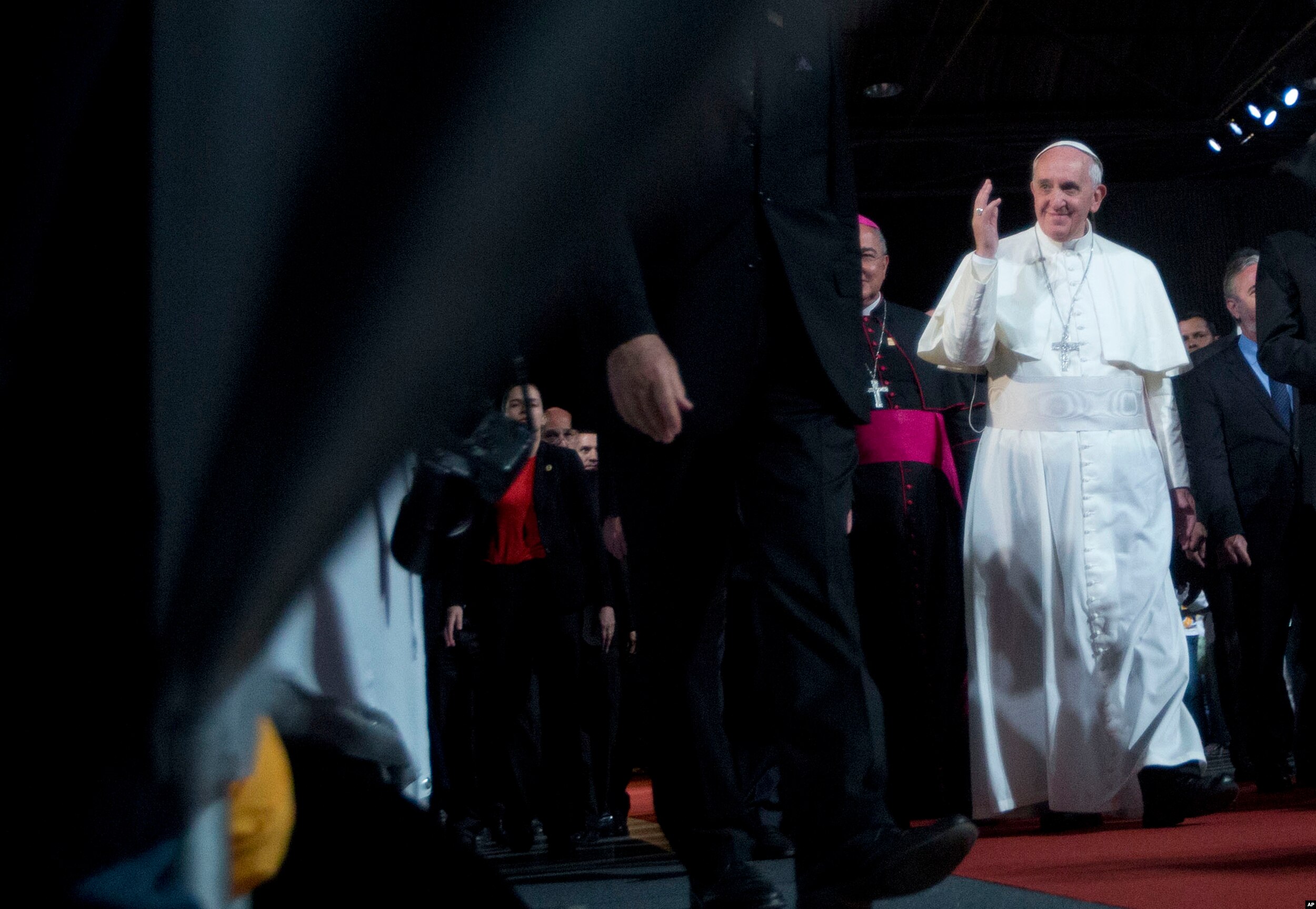
Pope Francis arrives to a farewell ceremony at the Rio de Janeiro airport, July 28, 2013.
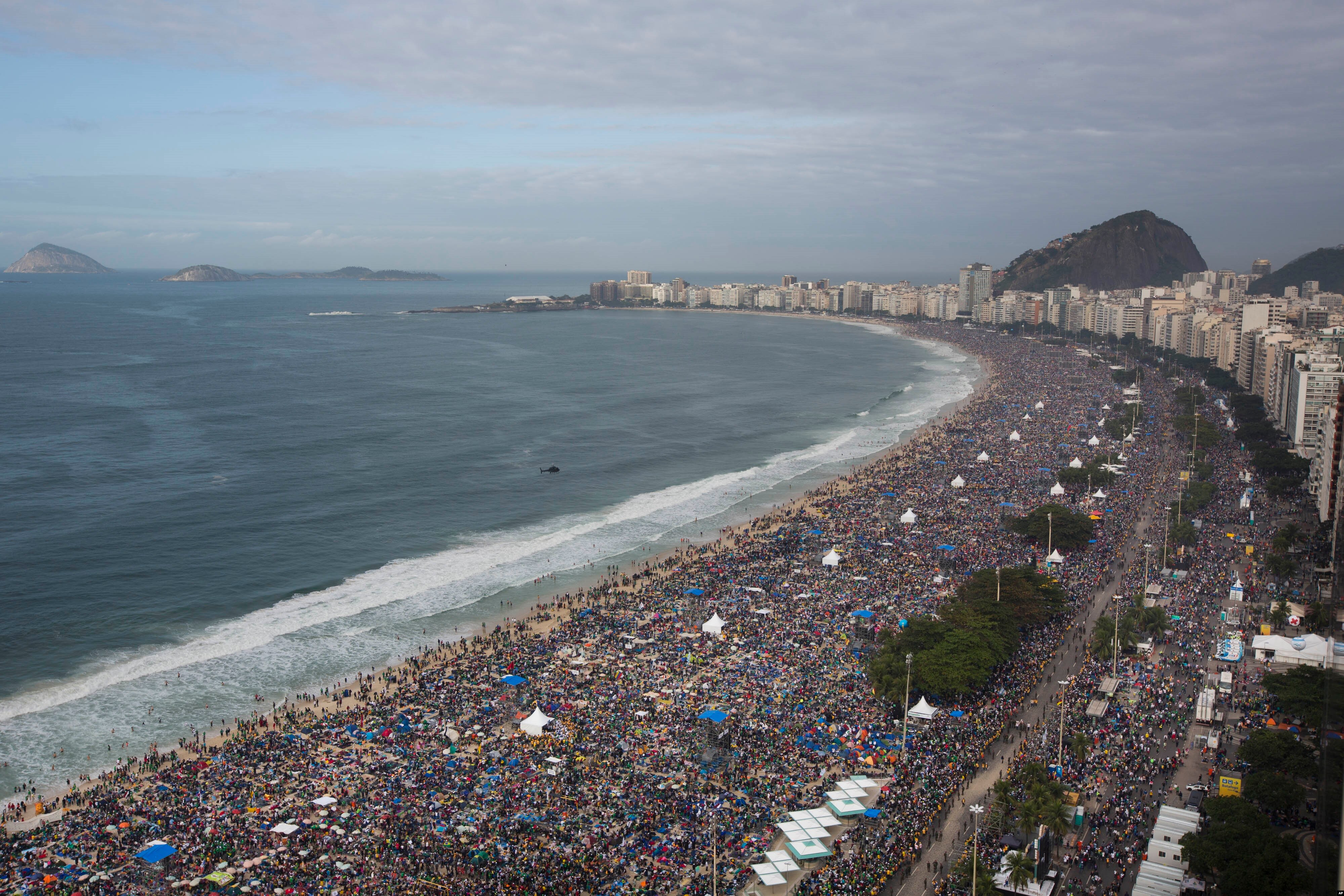
People pack Copacabana beach in Rio de Janeiro for Pope Francis' final mass for World Youth Day, July 28, 2013.
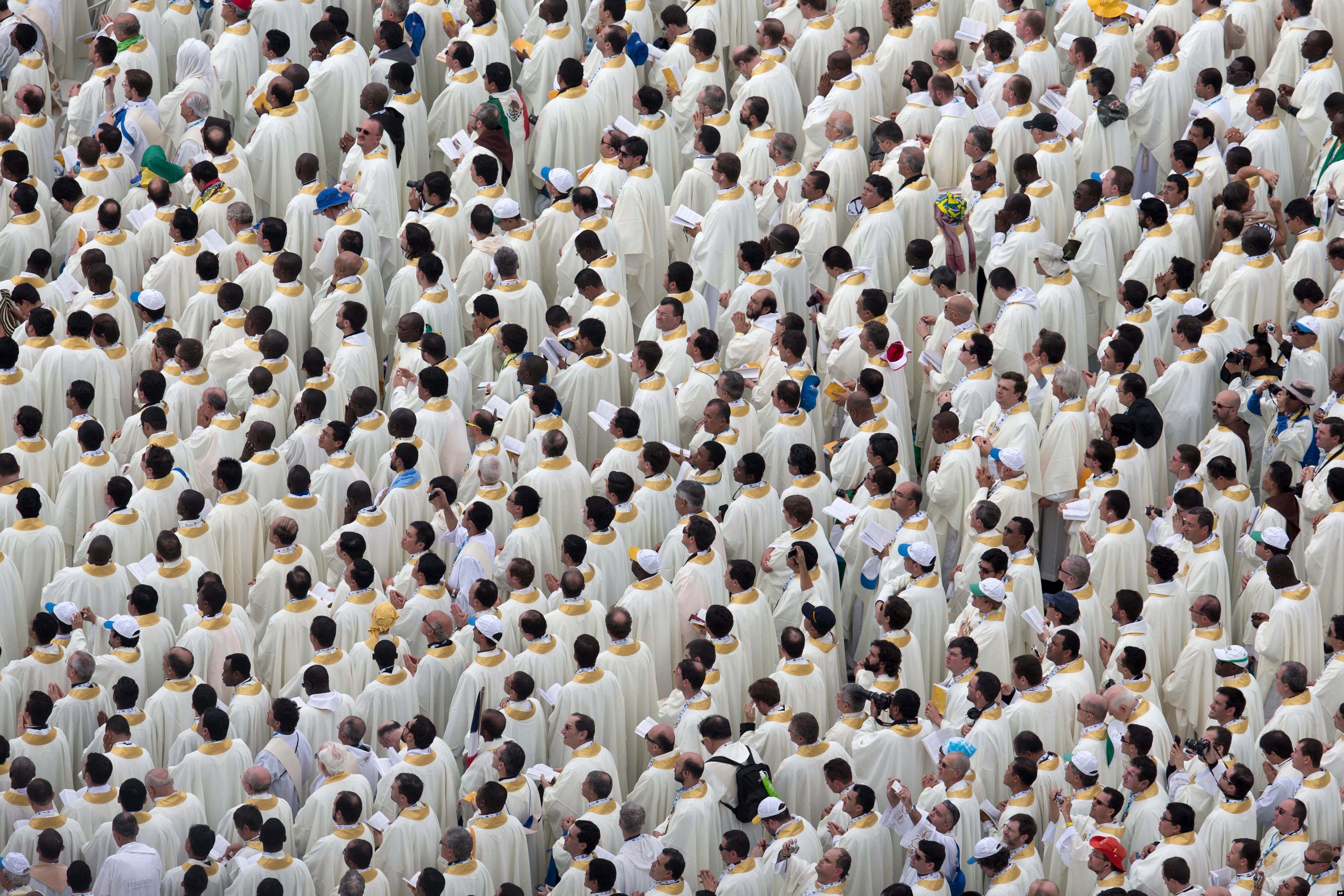
Clergy attend a Mass celebrated by Pope Francis on the Copacabana beachfront, in Rio de Janeiro, July 28, 2013.
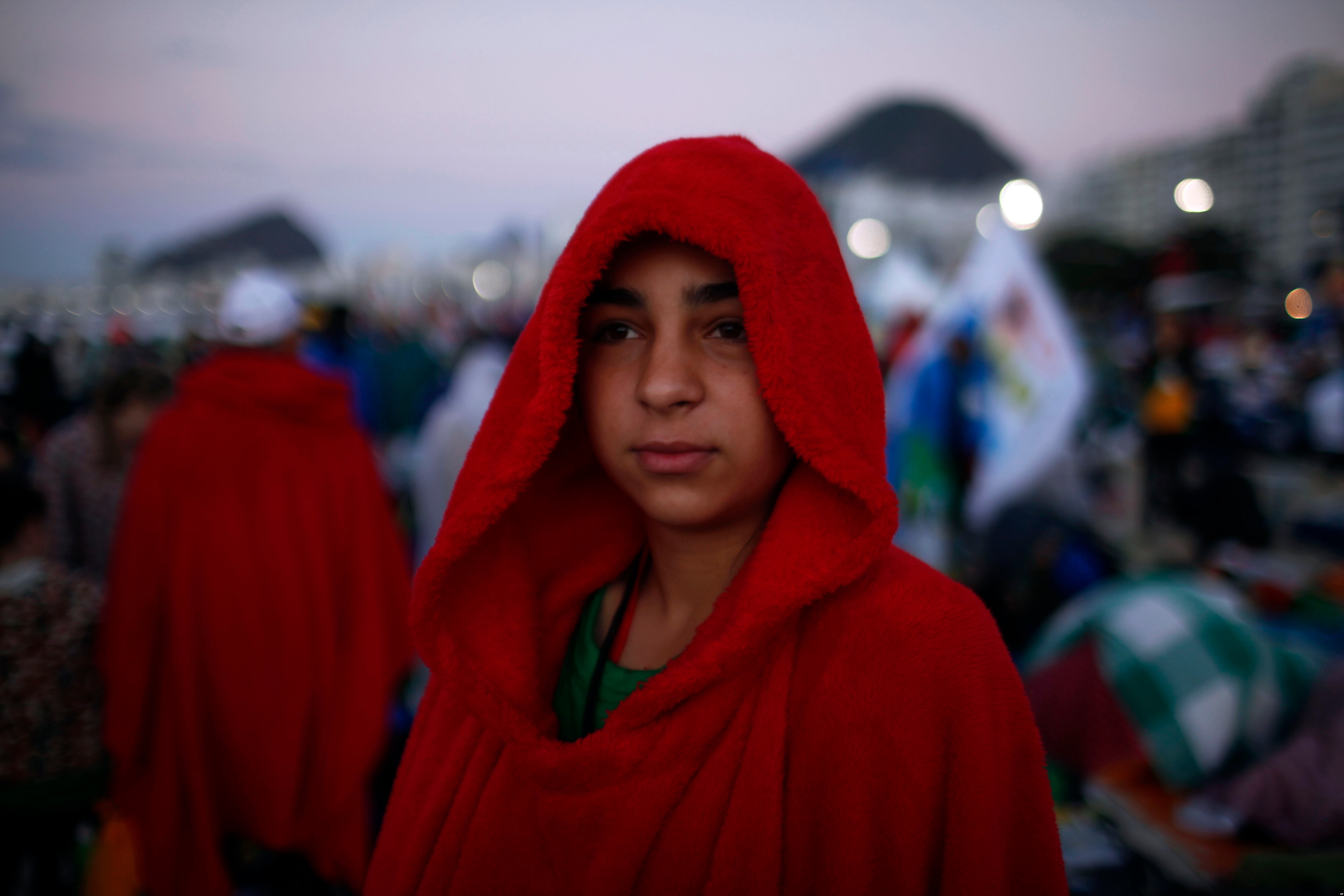
A pilgrim wakes up after a night of vigil in Copacabana beach in Rio de Janeiro, July 28, 2013.
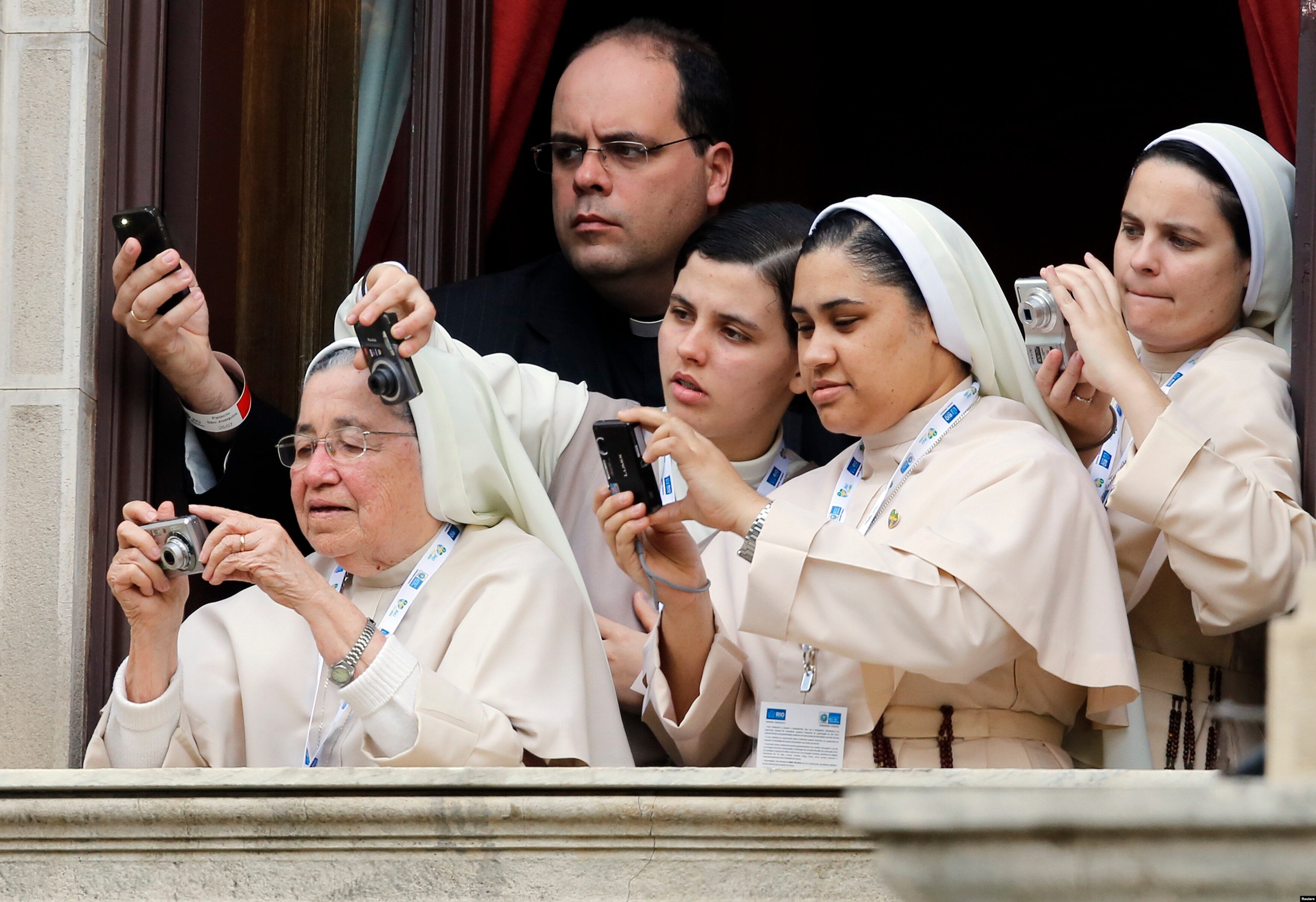
Nuns and a priest take pictures as Pope Francis arrives at Sao Joaquim Palace in Rio de Janeiro, July 26, 2013.?
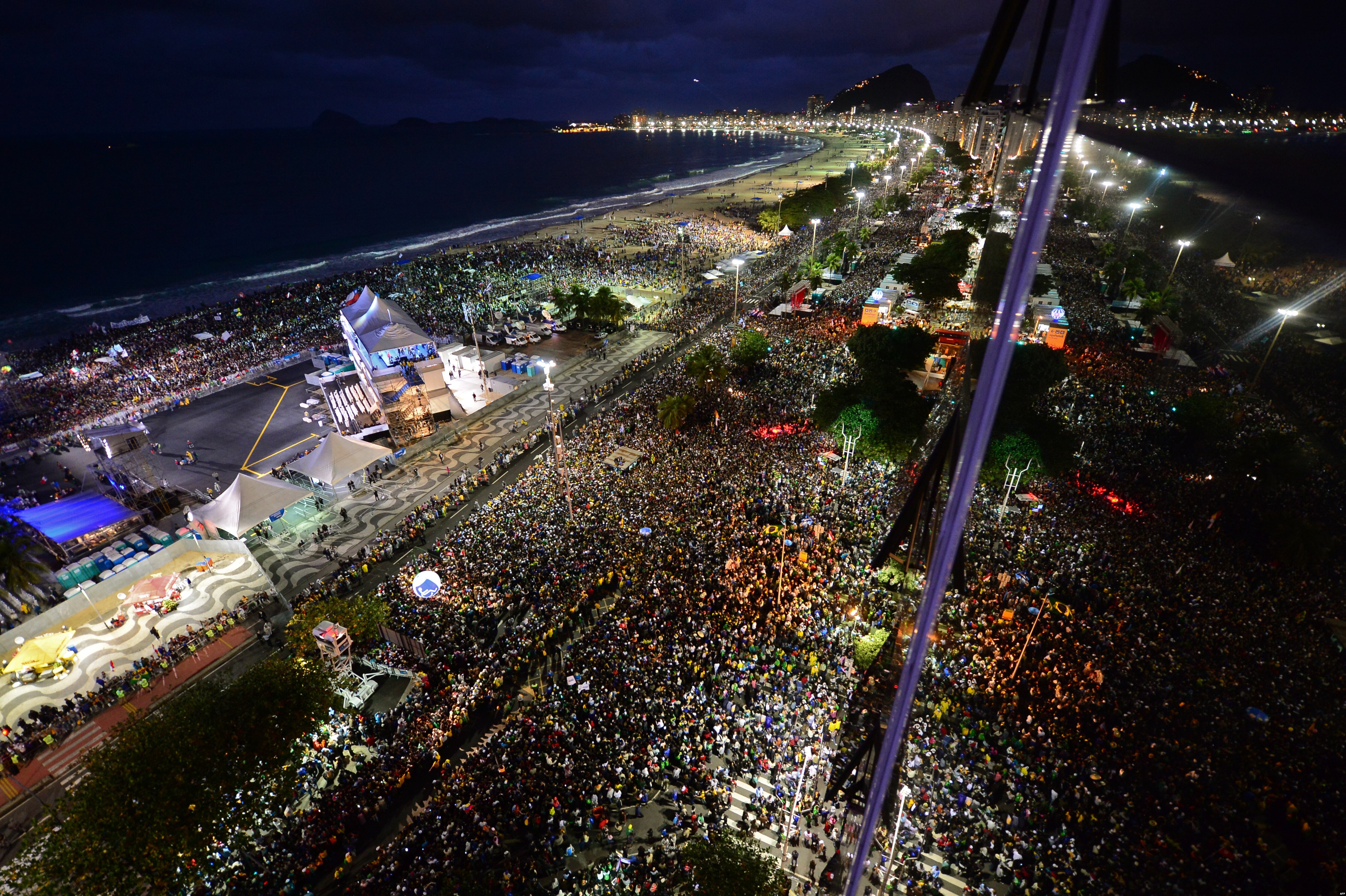
Thousands of young people gather at Rio de Janeiro's iconic Copacabana beachfront on July 25, 2013 for the welcoming of Pope Francis to World Youth Day ceremonies.
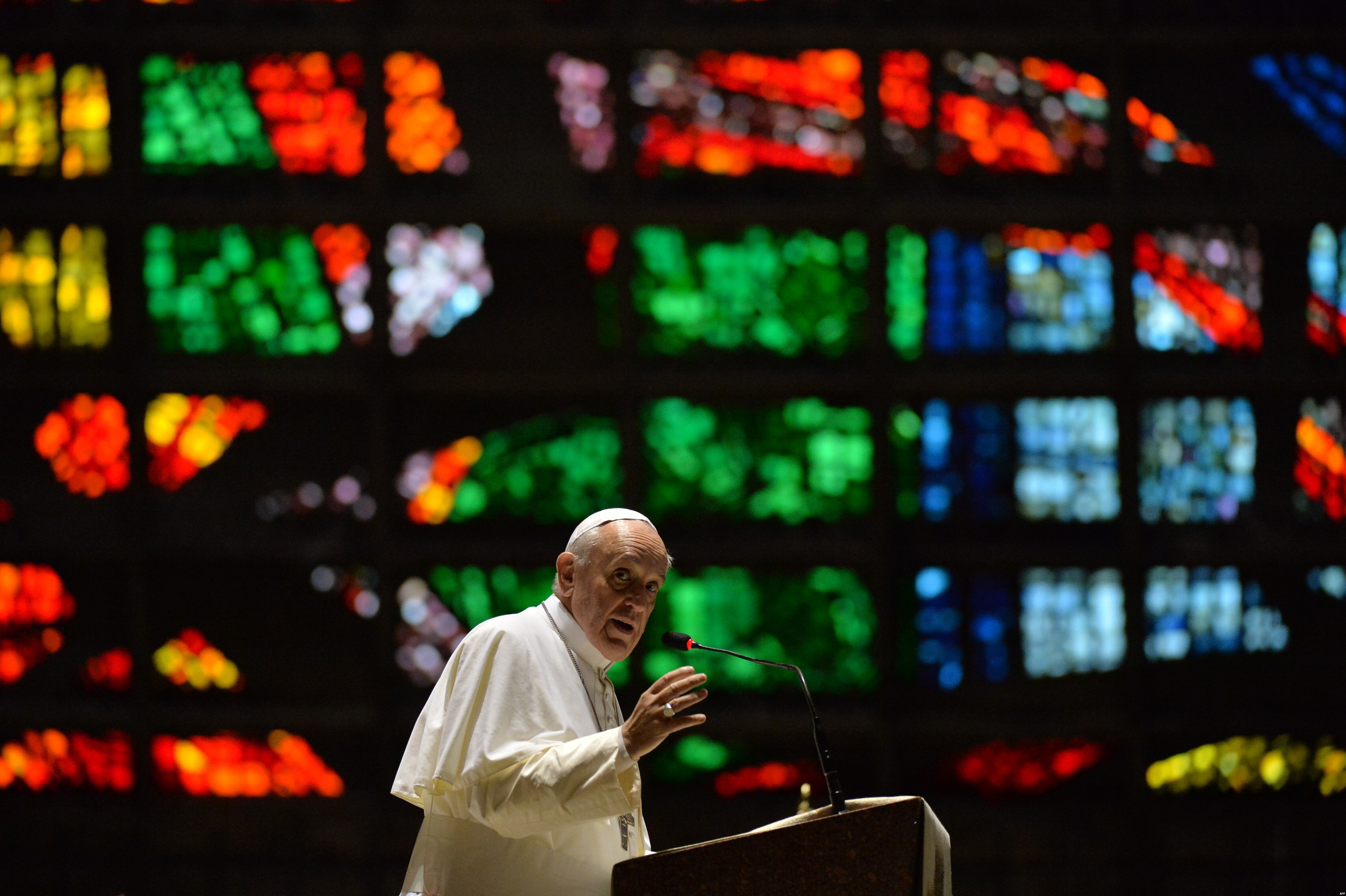
Pope Francis delivers a speech during a visit to the Cathedral of Rio de Janeiro, July 25, 2013.
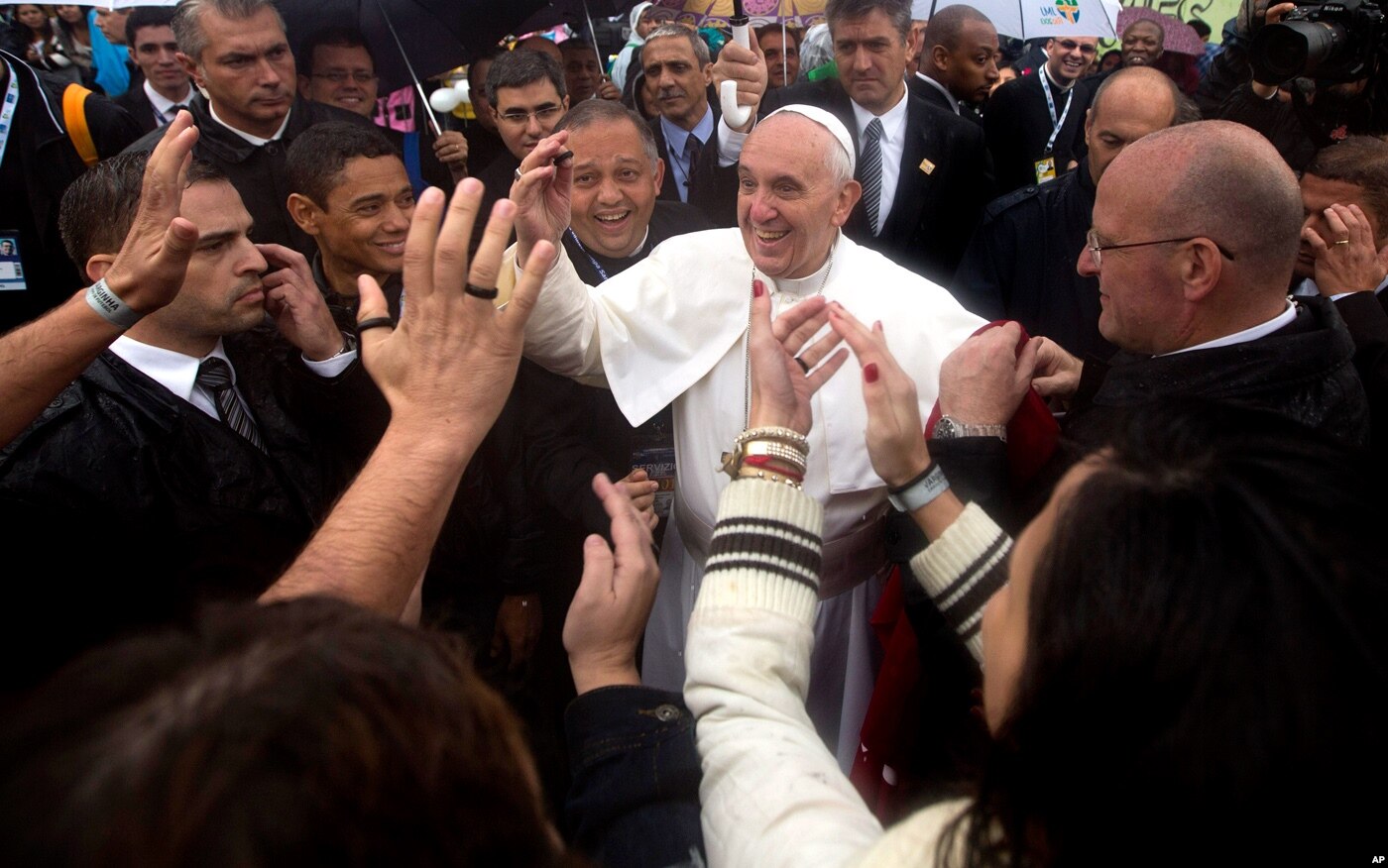
People greet Pope Francis as he visits the Varginha slum in Rio de Janeiro, Brazil, July 25, 2013.
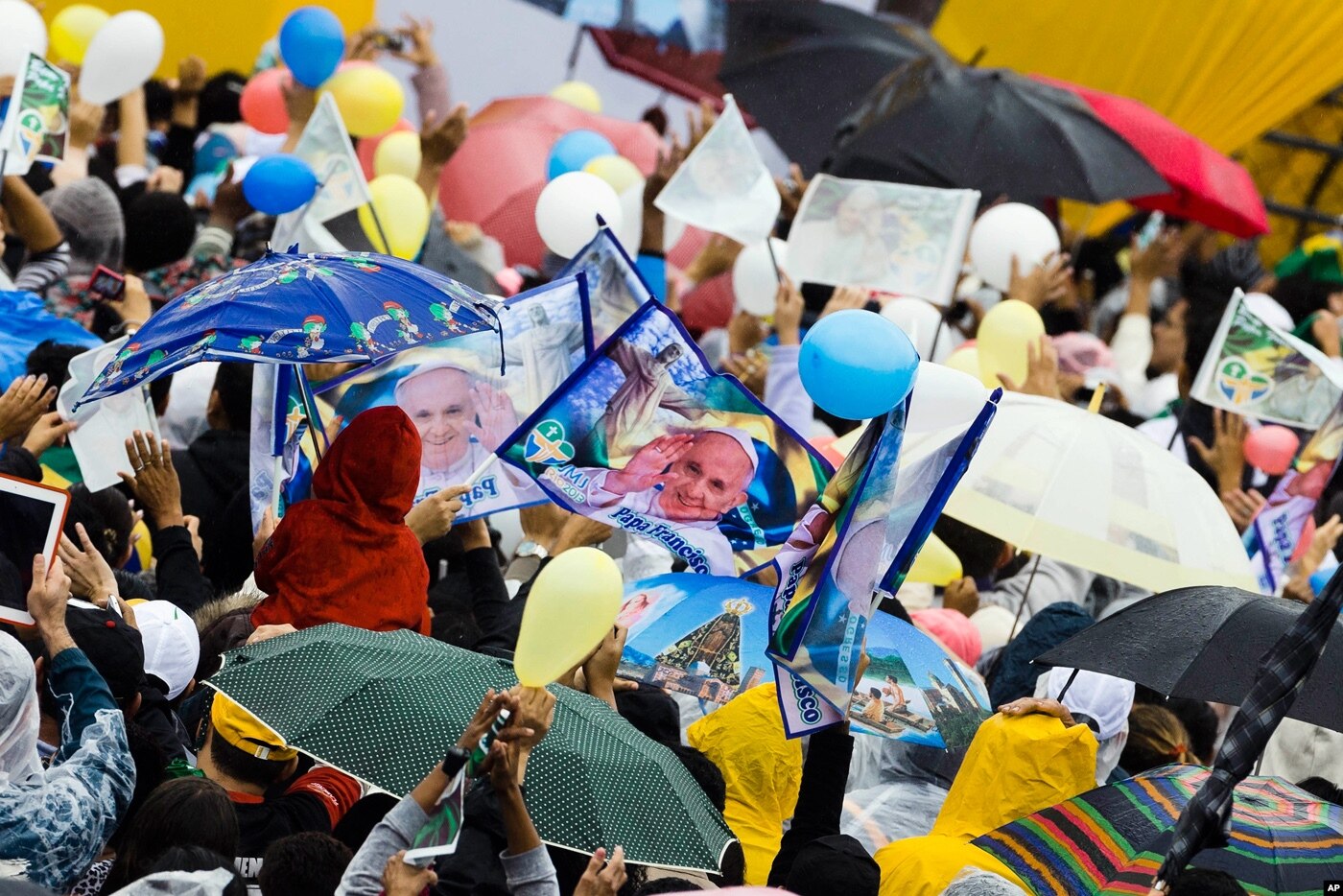
A crowd waits for the Pope ?to arrive at the Varginha slum in Rio de Janeiro, July 25, 2013.
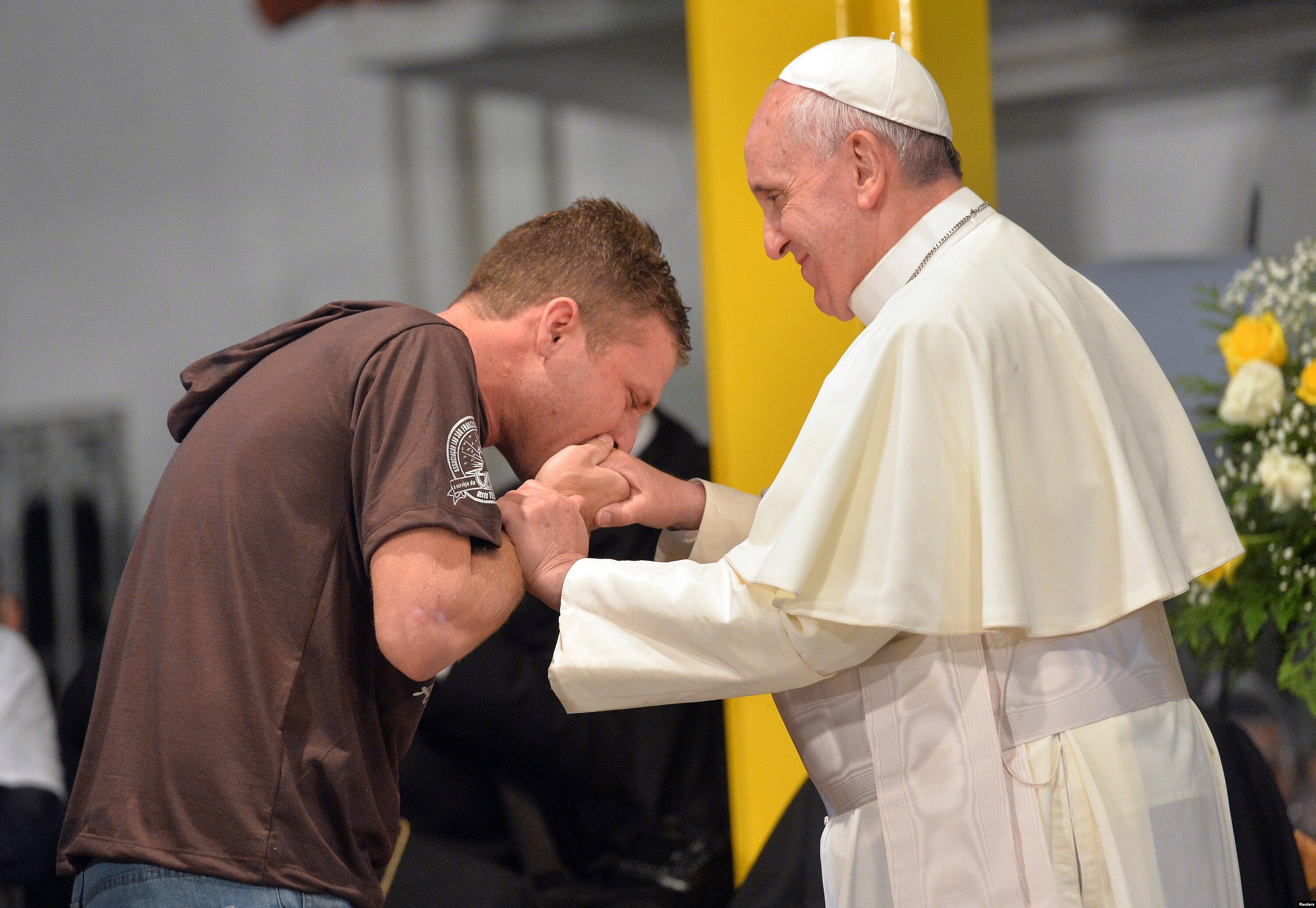
A patient kisses the hand of Pope Francis at the Hospital Sao Francisco in Rio de Janeiro, July 24, 2013.
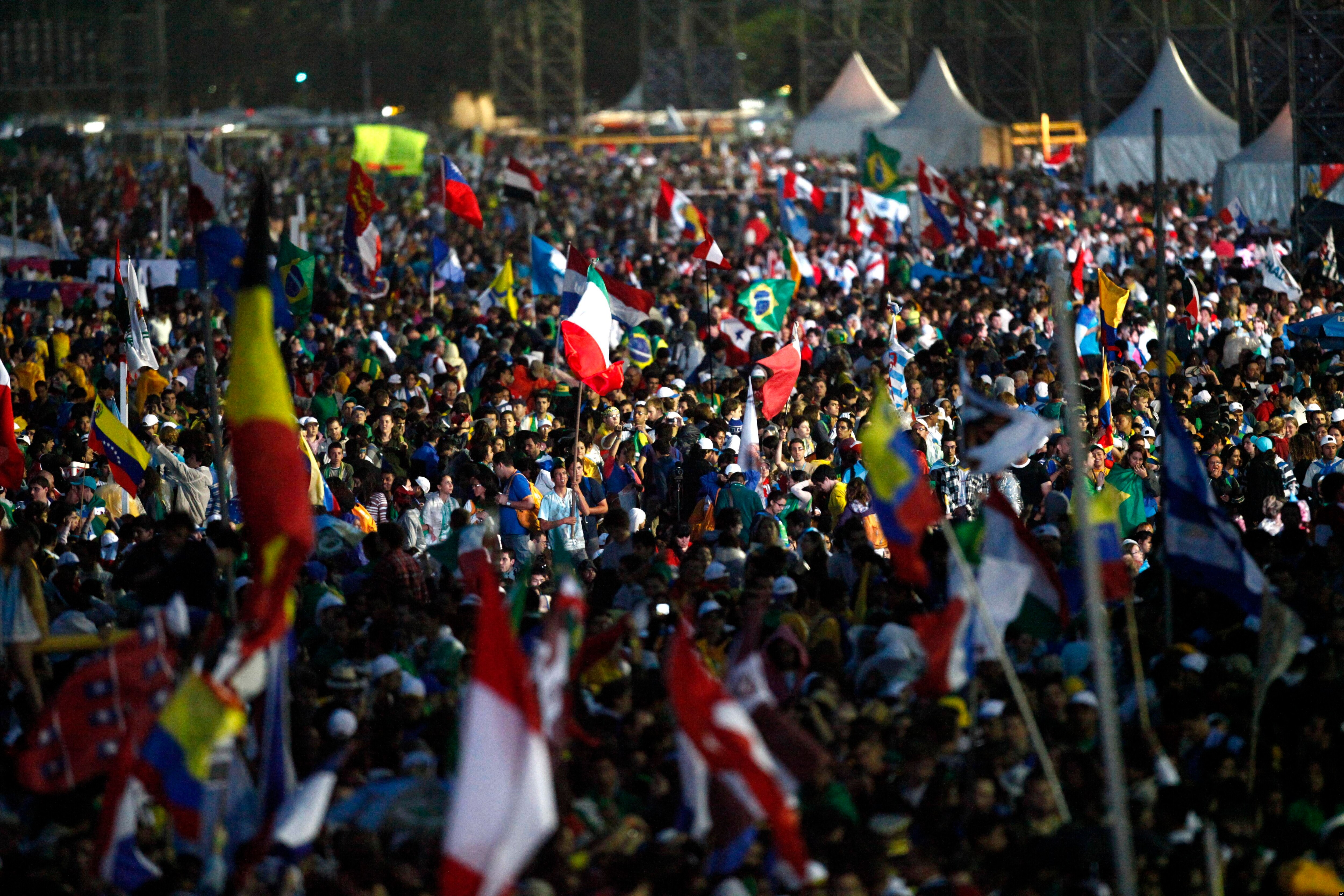
Thousands of young pilgrims gather on Copacabana Beach for a World Youth Day Mass in Rio de Janeiro, Brazil, July 23, 2013.
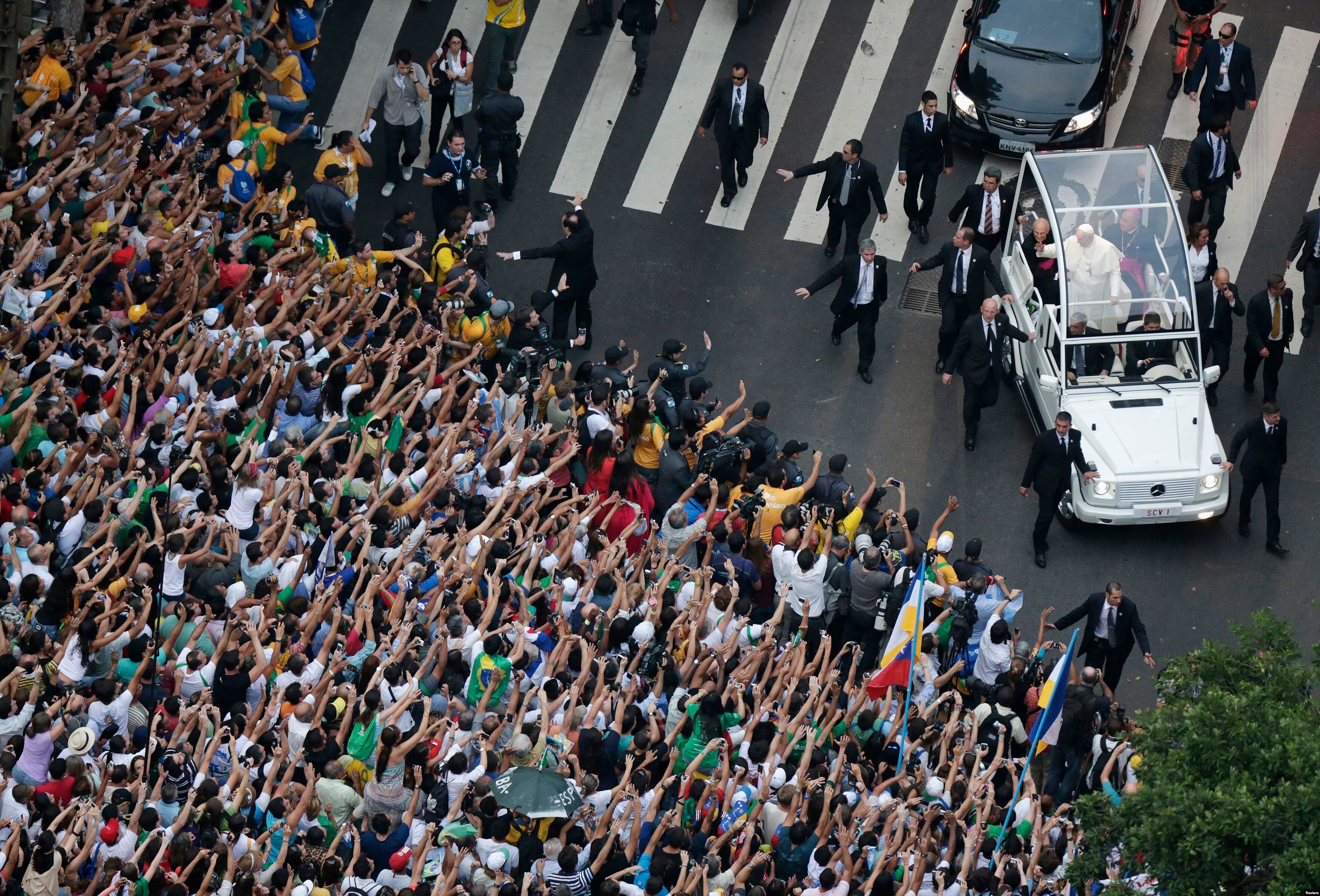
Pope Francis greets the crowd of faithful from his popemobile in downtown Rio de Janeiro, July 22, 2013.
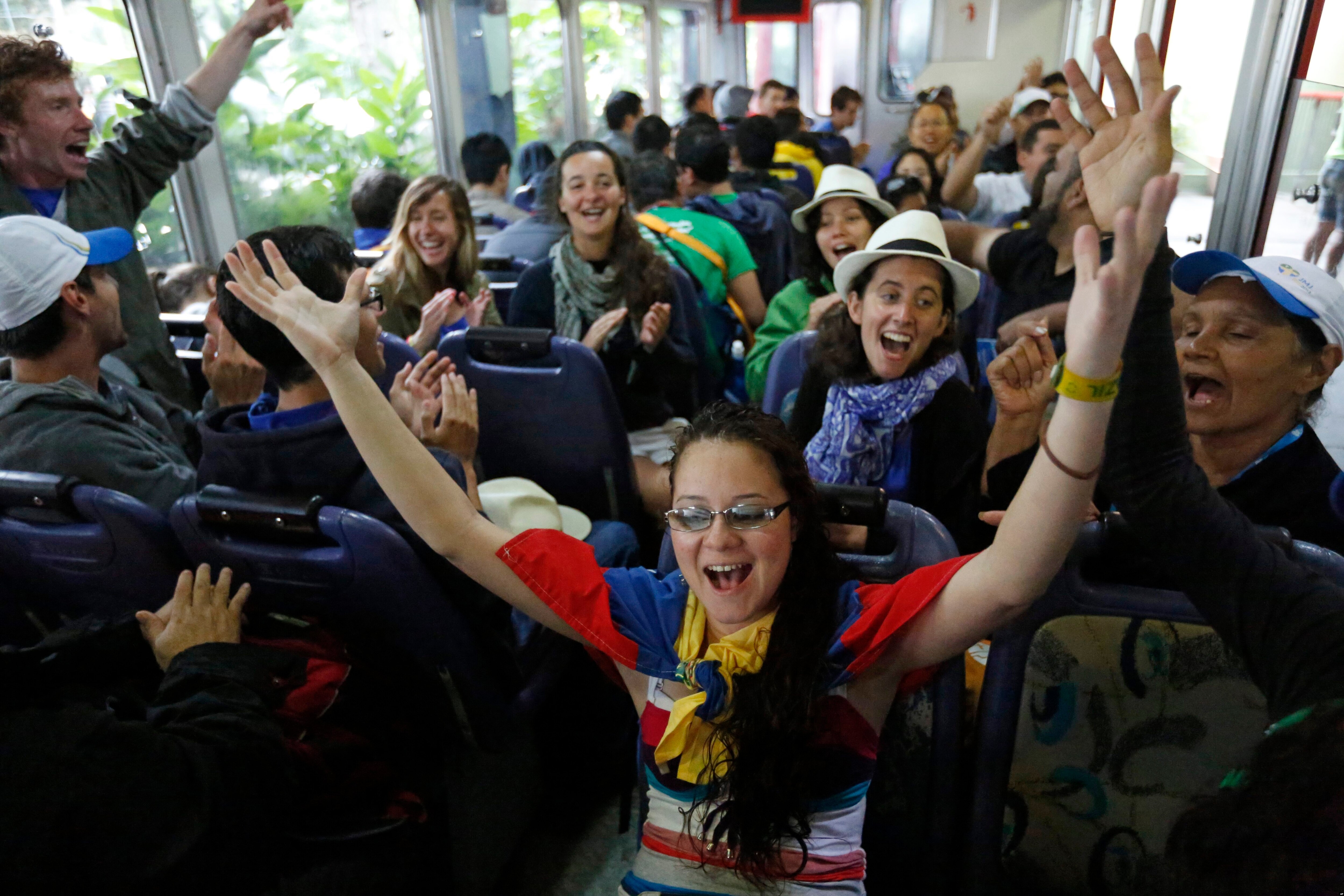
Youth from France, Venezuela and Canada who are in Brazil for World Youth Day events sing songs as they ride in a train that travels to Corcovado mountain where the statue Christ the Redeemer stands over Rio de Janeiro, Brazil, July 23, 2013.
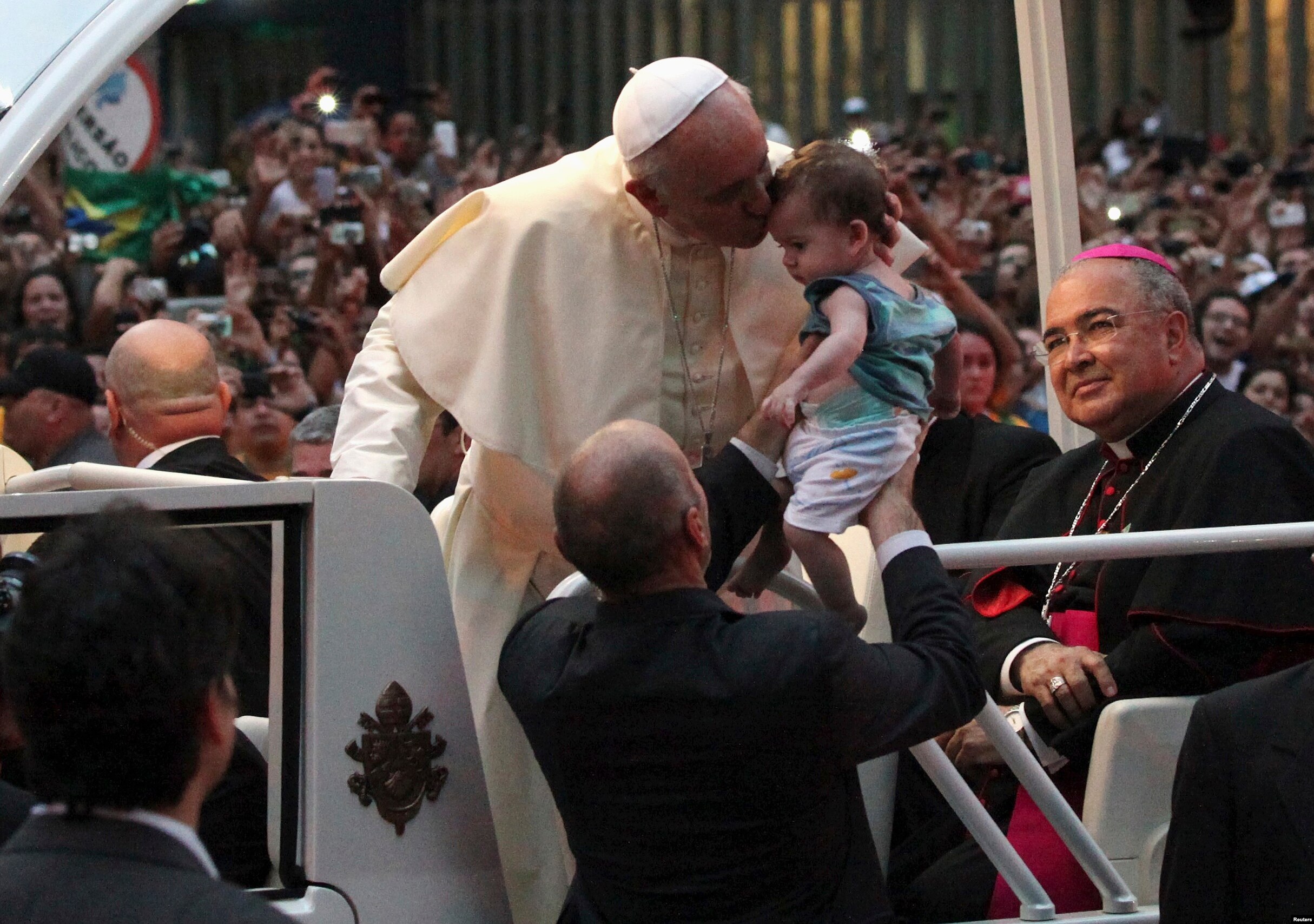
Pope Francis kisses a baby while greeting the crowd of faithful from his popemobile in downtown Rio de Janeiro, July 22, 2013.

Pope Francis shakes hands with Brazilian President Dilma Rousseff after receiving a painting of Rio de Janeiro during a welcoming ceremony in Rio de Janeiro, July 22, 2013.
megan fox Lane Goodwin Romnesia Tagg Romney Bosses Day Cabin Fever 2 Alexis Wright Zumba
Source: http://feeds.celebritybabies.com/~r/celebrity-babies/~3/vEHPczdR90A/
jimmy kimmel amzn white house correspondents dinner phoenix coyotes bruce irvin charlie st cloud young jeezy
Sorry, Readability was unable to parse this page for content.
Isaac path Tropical Storm Isaac path Hurricane Katrina Hurricane Isaac Path Isaac Hurricane earthquake san diego Hurricane Isaac
 Alexis Knapp ? scary: 30,000 bees swarm couple, end up killing two ponies ? RIP radio host Kidd Kraddick ? Orca grabs dolphin in the air ? this is terribly wrong and will end up being a big story ? idiot tries to rob gun store with baseball bat ? how did this famed hacker die? ? there?s a pay-to-stay-in-jail program in California ? Juror talks about changing from 2nd degree murder to acquittal ? Spain has a twitter hotel, where hookups appear easy ? gunman in Florida kills six before police can kill him ? TV show executive producer pleads guilty in gambling ring tied to Russian mob ? this GIF is probably ancient, but that doesn?t make it any less funny ? a squirrel in LA had the plague? ? he?s going to win this workmen?s comp case, right? ? bride, best man, die in boat crash two weeks before the wedding ? the girl Anthony Weiner was sexting did a bikini photo shoot ?
Alexis Knapp ? scary: 30,000 bees swarm couple, end up killing two ponies ? RIP radio host Kidd Kraddick ? Orca grabs dolphin in the air ? this is terribly wrong and will end up being a big story ? idiot tries to rob gun store with baseball bat ? how did this famed hacker die? ? there?s a pay-to-stay-in-jail program in California ? Juror talks about changing from 2nd degree murder to acquittal ? Spain has a twitter hotel, where hookups appear easy ? gunman in Florida kills six before police can kill him ? TV show executive producer pleads guilty in gambling ring tied to Russian mob ? this GIF is probably ancient, but that doesn?t make it any less funny ? a squirrel in LA had the plague? ? he?s going to win this workmen?s comp case, right? ? bride, best man, die in boat crash two weeks before the wedding ? the girl Anthony Weiner was sexting did a bikini photo shoot ?
Would you like to know every college football team?s record vs. the spread in conference play over last 10 years? Of course you would. [David Purdum Sports]
Hasn?t this been known for years? You don?t pay big money for MLB stars over 30. [Atlantic]
NBA writer Chris Palmer is leaving ESPN. [Inside Hoops]
Dan Koppen, the Denver Broncos center, suffered a torn ACL and is lost for the season. [Denver Post]
Jonathan Papelbon, the Phillies closer, rips the team and club, says major changes need to happen. [MLB.com]
Terrific story about how a nurse in the stands at a basketball game saved a player?s life. [Charlotte Observer]
Meghan McCain is getting her own TV show. [Washington Post]
?Radio host and former UT football player Erik Ainge was arrested early Sunday morning on DUI charges.? [WATE]
Rex Ryan and Jeff Weeks, college buddies, are together again. [NY Daily News]
David Shaw doesn?t seem to want to pay college football players. ?I like to say that our job is to teach these guys?how?to make a living and not have them make a living in college.? If it hurts him in recruiting, the Jets will probably need a new coach next year. [CBS Sports]
Marcus Camby, 39, has signed a 1-year deal with the Rockets. [Chronicle]
?Greece?s Unemployed Young: A Great Depression Steals the Nation?s Future.? [Business Week]
JaVale McGee at the Drew League. He dunked. A few times.
Bears seem really cool! A life of scratching your back against a tree seems awesome.
Kevin Durant also toyed around in the Drew League. This dunk ? don?t you wish you were taller so you could dunk? Anyone can score a TD, hit a home run, score a goal ? I wonder what the percentage of humans is in the United States that can dunk?
I?m old. This video has 35 million views. I only learned about it this past weekend. Yes, I saw Pitch Perfect a few weeks ago (wasn?t bad). I?ve never seen anyone put this video on Facebook or tweet it, and nobody ever emailed it to me. I don?t commute so I rarely listen to the radio in the car. My 2-year old loves this, though, so I heard it enough this weekend to make up for all the lost time.
Barbara Palvin Yahoo Fantasy Football Nick Foles Auguste Rodin Breaking Amish Indianapolis explosion mike brown
Get inside the head of top MMA coach John Crouch as he talks the UFC on Fox 8 performances of pupils John Moraga and Yaotzin Meza this past weekend.
John Crouch was a busy man last Saturday night (July 27, 2013) from the opening bout of the evening to main event of UFC on Fox 8 in Seattle, Washington.
The MMA Lab head coach was in the corner of Yaotzin Meza as he scored his first career UFC win as well as flyweight title challenger John Moraga, who came up short against Demetrious Johnson in the headlining fight on national television.
Needless to say, it was a night of major ups and downs.
Crouch opened up to MMAmania.com about his athlete's performances during a guest appearance on The Verbal Submission, talking the emotions of seeing Meza's first victory in the Octagon, the heart displayed by Moraga in defeat and the flaws in preparation for the flyweight title fight in this exclusive interview.
Check it out:
Brian Hemminger (MMAmania.com): Let's start with Yaotzin Meza. People weren't quite giving him respect despite fighting at featherweight on short notice against the number two guy in the world. He overcame some adversity against John Albert and ended up pulling off the submission. What were your thoughts on that?
John Crouch: Yeah, he did great. He's one of our flagship members that really helped build this team and has been grinding away for years. It was very rewarding to see him get a win because he's worked so hard for guys like Benson and Varner and Efrain Escudero. He's in here every day doing the right stuff. It's a really happy moment for me.
It was his very first fight at 135 last night. He did a great job. I think he got a bit tired but it was a scrambly fight and you can get tired from those things. He set his goals 6-7 weeks out and hit the mark perfectly. I think it's the hardest the first time you make the cut so it'll be easier for him next time.
Brian Hemminger (MMAmania.com): Let's talk about the finish of that fight. Meza lands some leg kicks to open the round and Albert attacks with a triangle choke which looked to be locked in but Meza turns to the side and he just lets go, which allows Meza to jump on him, take his back and submit him. What did you see there?
John Crouch: John had a pretty good triangle and Yaddie turned to the side. When you turn to the side it changes the angle and it hurts your ankle. Depending on the length of the guy, sometimes you don't have to let go. It depends on the squeeze. I think he gassed himself out and let go but there wasn't a really good squeeze on the triangle at that point. When he let go, he either hurt his foot or didn't think he had it anymore but he certainly gave up the position.
Brian Hemminger (MMAmania.com): What do you think of Meza's potential at 135 pounds?
John Crouch: I think once he gets settled in the division, he'll do pretty good. We took that Mendes fight at featherweight on eight days notice and Chad's a monster. You have your doubts coming into the second one and it's your first time cutting down to 135. UFC is a big deal and there's a lot of pressure, lot of press. I think all of those things together, he has what it takes to have a solid UFC career. That's what I'm hoping for because he's a great person, a really nice kid and a great teammate. Any career benefits he has, I'd be more than happy for.
Brian Hemminger (MMAmania.com): Let's transition to the main event. How do you think Moraga handled everything jumping from opening up two Facebook preliminary fights to the main event for the title?
John Crouch: I don't think it affected him at all. I really don't. He's not the kind of guy that gets affected by that. We lost the fight but he wasn't frozen. He didn't not do what he was trying to do. He just ran into someone that was having a better night in my opinion.
Brian Hemminger (MMAmania.com): What did you think about his display of heart in the fight? He was down three rounds yet landed that big right hand in the fourth when many others might have been broken from the onslaught of takedowns Johnson was throwing his way.
John Crouch: Yeah the kid's heart is not a question. We just ran into someone that was having a good night and DJ's a great opponent. I wasn't worried about Johnny quitting. He was in there the entire time trying as hard as he could. I wasn't worried about him. He's never going to stop trying. He may get beat, but he's not going to quit. I was proud of him and was hoping that shot would be a bit cleaner and maybe dazed DJ a bit more and gave us more of a shot but it's what it was. I was really proud of him.
Brian Hemminger (MMAmania.com): How do you help him bounce back from a tough loss like that? Some guys handle it differently than others, and as you say, John is a little bit different.
John Crouch: He's gonna do great. He's gonna be sad and feel bad for a few weeks probably, but then he's going to use it to fuel his training and we're gonna work on his ground game a bit more. I thought he won the stand-up game and DJ thought the same thing. That's why he was going for those double legs and he did a great job of that. I think Johnny now will work on rounding out his game more. I think he realizes there's a few specific things we need to work on.
Brian Hemminger (MMAmania.com): Did you have any specific corner strategy? I know the primary coach was going over striking strategy in between rounds. Was there anything you were focusing on?
John Crouch: Well Trevor Lally is from ACS and he's been Johnny's striking coach. John wanted it to be more of a stand-up fight so he was trying to get him to do what he wanted on the feet. Really I took a secondary role there last night, but I really wanted him to wrestle more aggressively because he's a good wrestler. People probably shake their head at me for saying that because he didn't do a good job wrestling last night. We didn't do a good job preparing him. I should take the blame on myself. We should have prepared better for DJ's double leg. I wanted him to be more aggressive in the wrestling department. We'll be better next time. You learn from your losses and a true competitor, they never quit. It won't get him down for long. This will be a stepping stool to a higher place for him.
Brian Hemminger (MMAmania.com): You mention using this loss as fuel. Do you think he still has what it takes to be a champion someday?
John Crouch: Oh absolutely. Absolutely. He's got the most important part. He's super mentally strong and he's got a big heart. You can't teach that stuff. You can teach all the other stuff. You can teach takedown defense and a rear naked choke, but it's hard to teach somebody to have heart and to not quit. He's got those things so we'll just build on that and he'll be back for sure.
You can follow John on Twitter @JCBJJ.
mayan calendar end of the world end of the world december 21 2012 norad 12/21/12 winter solstice

Bob Mansfield, until today listed as senior vice president of technologies, is no longer part of Apple's leadership, although he's not left the company either. Apple's Steve Dowling provided the following statement to John Paczkowski of All Things D:
?Bob is no longer going to be on Apple?s executive team, but will remain at Apple working on special projects reporting to Tim,? company spokesman Steve Dowling told AllThingsD. He declined any further explanation, refusing to comment on the reasons behind Mansfield?s abrupt demotion or whether Apple plans to appoint a new SVP of technologies.
A similar statement was also provided to Poornima Gupta of Reuters, who shared it earlier on Twitter. Mansfield was originally set to retire in January of 2012, but he later returned, reportedly at the behest of Tim Cook, to work on - wait for it - future projects. Following a leadership shake-up, Mansfield was named senior vice president, technologies. Most recently Mansfield has been connected to the iWatch story.
As of today, he's back where he was, pre-shake-up. At least for now. No more word yet on what exactly is happening or why.
Source: All Things D
Source: http://feeds.smartphonemag.com/~r/iPhoneLife_News/~3/VcwEZh0LFl8/story01.htm
SEC Championship Game 2012 kansas city chiefs Javon Belcher express kindle fire Jenny Johnson olivier martinez
Martha C. White NBC News contributor
3 hours ago

J. Scott Applewhite / AP file
Mayor Vincent Gray of Washington, D.C.
Wal-Mart has a reputation to protect: Its legendary, bare-knuckled labor tactics.
That's why the world?s largest retailer has threatened to scrap at least three of six stores planned for the nation?s capital if the city signs into law a bill requiring big-box stores to pay workers at least $12.50 an hour. Six other retailers have jumped on board, sending a letter to D.C. Mayor Vincent Gray that warned, ?Any future plans for retail expansion in the city must be revisited.?
It?s a showdown labor experts predict will be repeated in other cities, as cash-strapped municipalities try to pare back public assistance for the working poor and large retailers look to America?s cities for future growth.
Proponents of the wage bill, formally called the Large Retailer Accountability Act, call Wal-Mart a bully.
?They are known to be quite resolute, willing to take local losses in order to maintain a reputation,? said Gary Burtless, labor economist at the Brookings Institution. ?It would be a huge blow to that negotiating stance if they ceded to demands from the District of Columbia.?
Dean Baker, co-director of the Center for Economic and Policy Research agreed: ?If they?re seen to just be making idle threats after they?ve built up such a reputation, that would be a huge cost to them.?
Robin Sherk, Kantar Retail?s director of Retail Insights, offered an alternative for Wal-Mart -- that it offer grocery delivery service operating out of a suburban base, or downsize its planned Supercenters so its store footprints fall below the 75,000-square-foot threshold stipulated by the bill. Walmart Neighborhood Markets average about 38,000 square feet.
?Wal-Mart definitely views the urban environment as a growth area,? Sherk said. ?I don?t think they?ll give up on D.C. ... They?ll evaluate other options.?
Retail and labor experts agree that the chain will walk away, taking a loss if necessary, on some or all of its planned stores if the wage bill prevails.
This prospect strikes fear in the heart of local developers, who were counting on Wal-Mart?s draw as an anchor tenant to attract other stores and financing.
Developer Gary Rappaport told the Washington Post, ?If there?s not a Wal-Mart at Skyland (Town Center), then Skyland is not able to go forward at this time.?
Wal-Mart said that in addition to abandoning the three projects still in the planning stage, it ?will start to review the financial and legal implications on the three stores already under construction.?
Typically, a store would be locked into a lease agreement once lenders come on board and construction begins. Getting out of that could be expensive for Wal-Mart at this stage ? two of the stores were scheduled to open this fall ? but developers could be left holding the bag if they were so eager to get Wal-Mart on board that they wrote an option to terminate into their contracts.
?When you?re trying to attract a retailer like Wal-Mart, you do a lot of unconventional things,? Maloney said. ?You will need to stretch a bit.?
City administrators have been trying to get Skyland off the ground for more than two decades now, and the prospect of another setback frustrates Victor Hoskins, deputy mayor for planning and economic development. Washington, D.C. has invested between $25 million and $30 million in the project.
Hoskins said other big-box chains were considering abandoning D.C. for the suburbs if the mayor signs the bill. ?We?ve heard from a couple of large format retailers," he said. "They?re concerned.?
Hoskins argued that the jobs and sales tax revenue big-box retailers would bring are something the city can?t afford to lose, but supporters of the wage bill charge that big-box stores like Wal-Mart inflict hidden costs on taxpayers and municipalities.
?We want to make sure we don?t allow large retailers to come in and pay poverty wages ? which basically is going to compel this government to pick up all the social costs,? said Vincent Orange, Washington, D.C. council member at large. ?I know that the wage Wal-Mart wants to pay will continue to have D.C. residents seeking public assistance in a number of ways.?
Wal-Mart says its average non-supervisory worker pay is nearly $12 an hour, but since that doesn?t include part-time or temp workers, critics call the number inflated. In 2011, research company IBISWorld estimated that Walmart sales associates earned an average of $8.81 an hour, and department managers earned an average of $11.22 an hour.
Orange pointed to a report issued in May by the Democratic staff of the U.S. House Committee on Education and the Workforce, which said every Wal-Mart Supercenter ?may cost taxpayers about one million dollars in higher usage of public-assistance programs? by workers and their families.
Burtless, the Brookings labor economist, concurred: ?As a nation, we?ve expanded programs that provide income supplements to low-wage workers ... It does work to the benefit of Wal-Mart as well as other low-wage companies in the U.S.?
Despite retailers? protestations, experts predict that the pull of the market will eventually be too much to resist.
?For [Wal-Mart] to continue to grow in America, it needs to grow in urban areas,? including Northeastern and Midwestern cities with strong pro-union roots, said Paul Osterman, professor of human resources and management at Massachusetts Institute of Technology. ?That?s why these fights are so bitter.?
More business news:
Follow NBCNews.com business onTwitter and Facebook
mickelson how to tie a tie sweet potato recipes the sound of music celebration church new york auto show 2012 tulsa
| Pune ???? Poona | |
|---|---|
| ???Metropolitan City??? | |
| Clockwise from bottom: the National War Memorial Southern Command, the HSBC Global Technology India Headquarters, Mahatma Gandhi Road, Fergusson College and Shaniwarwada | |
| Nickname(s): Queen of the Deccan, Oxford of the East, Vidya Nagari | |
| | |
| Coordinates: 18?31?13?N 73?51?24?E? / ?18.52028?N 73.85667?E? / 18.52028; 73.85667Coordinates: 18?31?13?N 73?51?24?E? / ?18.52028?N 73.85667?E? / 18.52028; 73.85667 | |
| Country | India |
| State | Maharashtra |
| District | Pune |
| Talukas | Haveli taluka |
| Government | |
| ???Mayor | Vaishali Bankar[1](NCP) |
| ???Municipal Commissioner | Mahesh Pathak |
| Area | |
| ???Metropolitan City | 700?km2 (300?sq?mi) |
| Elevation | 560?m (1,840?ft) |
| Population (2011) | |
| ???Metropolitan City | 3,115,431 |
| ???Rank | 9th |
| ???Density | 7,214/km2 (18,680/sq?mi) |
| ???Metro[2] | 5,518,688 |
| ? | [3] |
| Languages | |
| ???Official | Marathi |
| Time zone | IST (UTC+5:30) |
| PIN | 411 0xx |
| Telephone code | 91- 20- XXXX XXXX |
| Vehicle registration | MH 12 (Pune), MH 14 (PCMC) |
| Website | pune.nic.in |
Pune, formerly Poona (pronounced [pu?e?]?(![]() listen)), is the eighth largest metropolis in India, the second largest in the state of Maharashtra after Mumbai, and the largest city in the Western Ghats. Once the centre of power of the Maratha Empire, it is situated 560 metres above sea level on the Deccan plateau at the confluence of the Mula and Mutha rivers.[4] Pune city is the administrative capital of Pune district.
listen)), is the eighth largest metropolis in India, the second largest in the state of Maharashtra after Mumbai, and the largest city in the Western Ghats. Once the centre of power of the Maratha Empire, it is situated 560 metres above sea level on the Deccan plateau at the confluence of the Mula and Mutha rivers.[4] Pune city is the administrative capital of Pune district.
Pune is known to have existed as a town since 937 AD. Pune was originally called Punawadi.[5] In 1730, Pune became an important political center as the seat of the Peshwa, the prime minister of the Chhatrapati of Satara; it was during this era that Pune became the centre of Indian politics.[6] After the town was annexed to British India in 1817, it served as a cantonment town and as the "monsoon capital" of the Bombay Presidency until the independence of India.[7]
Today, Pune is known for its educational facilities and relative prosperity. Pune is the cultural capital of Maharashtra. Pune has well-established manufacturing, glass, sugar, and forging industries since the 1950-60s. It has a growing industrial hinterland, with many information technology and automotive companies setting up factories in Pune district. The city is known for various cultural activities like classical music, spirituality, theatre, sports, and literature. These activities and job opportunities attract migrants and students from all over India and abroad, which makes for a city of many communities and cultures.
Pune is ranked as a Gamma- Global City.
The name Pune is derived from Sanskrit Pu?yanagara "City of Virtue". The oldest reference to this name was found on a Rashtrakuta Dynasty copper plate dated 937, which refers to the town as Punya-Vishaya or Poonak-Vishaya.[8] By the 13th century, it had come to be known as Kasbe Pune or Punavadi.
The city's name is sometimes transcribed as Poona in English, a practice particularly common during the British Raj. The spelling Pune was formally adopted in 1976.[9]
Copper plates dated 858 AD and 868 AD show that, by the 8th century, an agricultural settlement known as Punnaka existed where Pune is today. The plates indicate that this region was ruled by the Rashtrakuta Dynasty. The Pataleshwar rock-cut temple complex was built during this era.
Pune was part of the Seuna Yadavas of Devagiri from the 9th century to 1327. In 1595, Maloji Raje Bhosale was appointed the jagirdar of Pune and Supe by the Mughal Empire.[8] It was ruled by the Ahmadnagar Sultanate until being annexed by the Mughals in the 17th century.
In 1625, Shahaji appointed Rango Bapuji Dhadphale as the administrator of Pune. He was one of the first major developers of the town, overseeing construction of the Kasba Peth, Somwar Peth, Raviwar Peth and Shaniwar Peth. After the destruction of the town in raids by the Adil Shahi dynasty in 1630, and again from 1636 to 1647, Dadoji Kondadev, a military and administrative officer of Shahaji Bhosale, oversaw redevelopment and construction of the area. He stabilised the revenue system of Pune and the neighbourhoods of Maval to the west of town. In addition, he developed effective methods to control disputes and enforce law and order. Construction began on the Lal Mahal palace, as Shahaji's son Shivaji was to move there with his mother Jijabai. The Lal Mahal was completed in 1640.[8] Jijabai is said to have commissioned the building of the Kasba Ganapati temple herself. The Ganesha idol consecrated at this temple is regarded as the presiding deity (gramadevata) of the city.[10]
Shivaji was crowned Chhatrapati in 1674, thus founding the Maratha Empire. He oversaw further development in Pune, including the construction of the Guruwar, Somwar, Ganesh and Ghorpade Peths. Shivaji Maharaj encouraged development of dams in Parvati and Kondhwa regions of Pune for agriculture purposes. Pune and surrounding villages later provided manpower for Shivaji's efforts to build an army during the period from 1645 to 1680. In between 1660 and 1670 the town was captured by Mughal General Shahista Khan, but was recaptured by the Marathas in 1670 after the battle of Sinhagad. During the 27-year long conflict between the Marathas and the Mughals, the town was occupied by Aurangzeb from 1703 to 1705; during this time the name of the town was changed to "Muhiyabad".[citation needed] Two years later, the Marathas recaptured Sinhagad fort and later Pune city from the Mughals as had been done in 1670.
In 1720, Baji Rao I was appointed Peshwa (Prime Minister) of the Maratha Empire, ruled by Chattrapati Shahu.[11] He selected Pune as his base and started construction of Shaniwar Wada on the banks of the Mutha. The construction was completed in 1730, ushering in the era of Peshwa control of the city. The patronage of the Peshwas resulted in the construction of many temples and bridges in the city, including the Lakdi Pul and the temples on Parvati Hill. Bajirao Peshwa also constructed an underground aqueduct to bring water from Katraj Lake to Shaniwar Wada. The aqueduct is still operational. Pune prospered as a city during the reign of Nanasaheb Peshwe. He developed Saras Baug, Heera Baug, Parvati Hill and new commercial, trading and residential localilties. The Sadashiv Peth, Narayan Peth, Rasta Peth and Nana Peth were developed in this era. The Peshwas fell into decline after their defeat in the 1761 Battle of Panipat. In 1802, Pune was captured by Yashwantrao Holkar in the Battle of Poona, directly precipitating the Second Anglo-Maratha War of 1803?1805.
The Third Anglo-Maratha War broke out between the Marathas and the British in 1817. The Peshwas were defeated at the Battle of Khadki (then transcribed Kirkee) on 5 November near Poona, and the city was seized by the British.[12] It was placed under the administration of the Bombay Presidency, and the British built a large military cantonment to the east of the city (now used by the Indian Army). The Pune Municipality was established in 1858. Navi Peth, Ganj Peth and Mahatma Phule Peth were developed during the British Raj.
Pune was an important centre in the social and religious reform movements of the late 19th century. Many prominent social reformers and freedom fighters lived here, including Bal Gangadhar Tilak (also known as Lokmanya Tilak), Vitthal Ramji Shinde, Dhondo Keshav Karve and Jyotirao Phule. Also, During 1902, Vinayak Damodar Savarkar resided in Pune when he enrolled in Fergusson College.
In late 1896, Poona (Pune) was hit by bubonic plague; and by the end of February 1897, the epidemic was raging, with a mortality rate twice the norm, and half the city's population fled. A Special Plague Committee was formed under the chairmanship of W. C. Rand, an Indian Civil Services officer. He brought troops to deal with the emergency. Although these measures were unpopular, the epidemic was under control by May. On 22 June 1897, during the Diamond Jubilee celebration of the coronation of Queen Victoria, Rand and his military escort Lt. Ayerst were shot while returning from the celebrations at Government House. Both died, Ayerst on the spot and Rand of his wounds on 3 July. The Chapekar brothers and two accomplices were charged with this murder, and with the shooting of two informants and an attempt to shoot a police officer. All three brothers were found guilty and hanged. An accomplice was dealt with similarly. Another, a schoolboy, was sentenced to ten years' hard labour.
Poona (Pune) is also associated with the struggle for Indian independence. Mohandas Gandhi was imprisoned at Yerwada Central Jail several times and placed under house arrest at the Aga Khan Palace in 1942?44, where both his wife and aide Mahadev Desai died.
After Indian independence in 1947, from Britain Poona (Pune) saw a lot of development, such as the establishment of the National Defence Academy at Khadakwasla and the National Chemical Laboratory at Pashan. Pune serves as the headquarters of the Southern Command of the Indian Army.[13] Industrial development started in the 1950s and '60s in Hadapsar, Bhosari, Pimpri, and Parvati.[14] Telco (now Tata Motors) started operations in 1961, which gave a huge boost to the automobile sector.
In July 1961, the Panshet and Khadakwasla dams broke and their waters flooded the city, destroying most of the older sections of town, facilitating the subsequent introduction of modern town planning concepts and the development of parts of Pune.[citation needed] The economy of the city witnessed a boom in the construction and manufacturing sectors. By 1966, the city had expanded in all directions.[14]
In 1990 Pune began to attract foreign capital, particularly in the information technology and engineering industries; new businesses like floriculture and food processing started to take root in and around the city. In 1998, work on the six-lane Mumbai-Pune expressway began, the expressway being completed in 2001.[15] IT Parks were established in Aundh, Hinjawadi and on Nagar Road. In 2008 the Commonwealth Youth Games took place in Pune, which encouraged additional development in the northwest region of the city.[16]
In July 2009, India's first death due to H1 N1 occurred in Pune. Later the city became an epicentre of swine flue due to the large number of H1 N1 cases.[17]
On 13 February 2010, a bomb exploded at the German Bakery in the upmarket Koregaon Park neighbourhood on the east side of Pune, killing 17 and injuring 60.[18] The explosion is now suspected to be an improvised explosive device using an ammonium nitrate fuel oil mix.[19] The blast was a first in what was until then the relatively safe environment of Pune.[20]
Pune is located 560?m (1,840?ft) above sea level on the western margin of the Deccan plateau. It is situated on the leeward side of the Sahyadri mountain range, which forms a barrier from the Arabian sea. It is a relatively hilly city, with its tallest hill, Vetal Hill, rising to 800?m (2,600?ft) above sea level. Just outside the city, the Sinhagad fort is located at an altitude of 1300 m.
Central Pune is located at the confluence of the Mula and Mutha rivers. The Pavana and Indrayani rivers, tributaries of the Bhima river, traverse the northwestern outskirts of metropolitan Pune.
Pune lies very close to the seismically active zone around Koyna Dam, about 100?km (62?mi) south of the city, and has been rated in Zone 4 (on a scale of 2 to 5, with 5 being the most prone to earthquakes) by the India Meteorological Department. Pune has experienced some moderate-intensity and many low-intensity earthquakes in its history.
Earthquakes felt in Pune with a magnitude of more than 3.0 are listed below.
The city of Pune can be divided into the following zones:
| Zone | Neighbourhood | Description |
|---|---|---|
| Central Pune | The seventeen Peths (markets) of Pune | These were established and developed during the Maratha and Peshwa rule, and are referred to as the old city. |
| New Developments (inner) | Deccan Gymkhana, Erandwane and Shivajinagar in the west; Camp, Bund Garden and Koregaon Park in the east; Swargate, Parvati Hill, Sahakarnagar, Mukund Nagar, Maharshi Nagar, Gultekdi and Salisbury Park to the south. | Bounded on the north by the Mula-Mutha river. |
| New developments (outer) | Khadki, Aundh and Ganeshkhind in the northwest; Kothrud and Paud Road in the west; Dattawadi, Sahakarnagar and Dhankawadi in the southwest; Bibwewadi and Lullanagar in the southeast; Yerwada, Wadgaon Sheri (including Kalyani Nagar and Shastri Nagar) in the northeast; Vishrantwadi in the north; Ghorpadi, Fatimanagar, Wanowrie and Hadapsar South to the east. | Several educational institutes are located in the Bibvewadi and Dhankawadi neighbourhoods. |
| Suburbs | Baner and Pashan in the northwest; Bavdhan and Warje in the west; Wadgaon Budrukh, Dhayari and Ambegaon in the southwest; Katraj, Wanawadi, NIBM, Kondhwa, Undri and Mohammedwadi in the southeast; Hadapsar, Mundhwa and Manjri in the east; Kharadi in the northeast; Dhanori and Kalas to the north. | Kharadi and Hadapsar are home to large IT parks |
The Pune Metropolitan Area also includes the following areas, located roughly to the northwest of Pune city. These are administered by the Pimpri-Chinchwad Municipal Corporation.
Pune has a tropical wet and dry climate with average temperatures ranging between 20 to 28 ?C (68?to 82??F).
Pune experiences three distinct seasons: summer, monsoon and a mild autumn.
Typical summer months are from March to May, with maximum temperatures ranging from 30 to 38 ?C (86?to 100??F). The warmest month in Pune is April; although summer doesn't end until May, the city often receives heavy thundershowers in May (and humidity remains high). Even during the hottest months, the nights are usually cool due to Pune's high altitude. The highest temperature ever recorded was 43.3 ?C (109.9??F) on 30 April 1897.[24]
The monsoon lasts from June to October, with moderate rainfall and temperatures ranging from 10 to 28 ?C (50?to 82??F). Most of the 722?mm (28.4?inches) of annual rainfall in the city fall between June and September, and July is the wettest month of the year.
Autumn begins in November; November in particular is referred to as the Rosy Cold (literal translation) (Marathi: ?????? ????). The daytime temperature hovers around 28 ?C (82??F) while night temperature is below 10 ?C (50??F) for most of December and January, often dropping to 5 to 6 ?C (41?to 43??F). The lowest temperature ever recorded was 1.7 ?C on 17 January 1935.[25]
| Climate data for Pune | |||||||||||||
|---|---|---|---|---|---|---|---|---|---|---|---|---|---|
| Month | Jan | Feb | Mar | Apr | May | Jun | Jul | Aug | Sep | Oct | Nov | Dec | Year |
| Average high ?C (?F) | 29.9 (85.8) | 31.9 (89.4) | 35.4 (95.7) | 37.7 (99.9) | 36.9 (98.4) | 31.7 (89.1) | 28.4 (83.1) | 27.4 (81.3) | 29.4 (84.9) | 31.4 (88.5) | 30.1 (86.2) | 28.9 (84.0) | 31.59 (88.87) |
| Average low ?C (?F) | 11.0 (51.8) | 12.1 (53.8) | 15.8 (60.4) | 19.9 (67.8) | 22.4 (72.3) | 22.9 (73.2) | 22.2 (72.0) | 21.6 (70.9) | 20.8 (69.4) | 18.5 (65.3) | 14.4 (57.9) | 11.5 (52.7) | 17.76 (63.96) |
| Precipitation mm (inches) | 0 (0) | 3 (0.12) | 2 (0.08) | 11 (0.43) | 40 (1.57) | 138 (5.43) | 163 (6.42) | 129 (5.08) | 155 (6.1) | 68 (2.68) | 28 (1.1) | 4 (0.16) | 741 (29.17) |
| Avg. precipitation days | 0.1 | 0.3 | 0.3 | 1.1 | 3.3 | 10.9 | 17.0 | 16.2 | 10.9 | 5.0 | 2.4 | 0.3 | 67.8 |
| Mean monthly sunshine hours | 291.4 | 282.8 | 300.7 | 303.0 | 316.2 | 186.0 | 120.9 | 111.6 | 177.0 | 248.0 | 270.0 | 288.3 | 2,895.9 |
| Source: HKO | |||||||||||||
| Pune growth? | |||
|---|---|---|---|
| Census | Pop. | %? | |
| 1851 | 73,209 | | |
| 1881 | 129,751 | | |
| 1891 | 161,390 | 24.4% | |
| 1901 | 153,320 | -5.0% | |
| 1921 | 133,227 | | |
| 1951 | 488,419 | | |
| 1961 | 606,777 | 24.2% | |
| 1971 | 856,105 | 41.1% | |
| 1981 | 1,203,351 | 40.6% | |
| 1991 | 1,566,651 | 30.2% | |
| 2001 | 2,540,069 | 62.1% | |
| Source: Census of India,[26]Imperial Gazetteer of India[27] | |||
As per the 2010 Census of India estimate, the population of the Pune urban agglomeration is to peg around 5,518,688[28] This includes the towns of Khadki, Pimpri-Chinchwad and Dehu. Growth in the software and education sectors has led to an influx of skilled labour from across India. The population of the urban agglomeration was estimated to be around 4,485,000 in 2005.[29] The migrating population rose from 43,900 in 2001 to 88,200 in 2005.[30] According to the Pune Municipal Corporation, 38.9% of the population lived in slums in 2001.[31] The sharp increase in censorial decade of 1991?2001 can be attributed to the absorption of 38 fringe villages into the city.[26] The literacy rate is about 81%.[32]
Marathi is the official and most widely spoken language, while Hindi and English are understood and spoken widely. Pune has a great Marathi influence as it was the bastion of the Maratha Empire.
Hinduism is the dominant religion in Pune. Many Churches, Masjids, Gurudwaras, Buddhist Viharas, Jain temples and other religious buildings are found throughout the city.[33] The most prominent communities include Marathas, Mahars, Mali, Brahmin, Shwetambar Jains,Digambar jains, Khandelwal Jains, Saitwal Jains, Chaturtha and Pancham Jains, Marathi Jains Marwaris, Punjabi and Sindhi people, along with the local communities. The most prominent Hindu temple in Pune is the Parvati Temple, located on Parvati hill and visible from most of the inner suburbs. The most visited temple is likely the Chaturshringi Temple, located on the slopes of a hill in the northwest of the city. During Navratri, there is a large procession to this temple and worshippers gather from around the country to pray here. The presiding god of Pune city is the Kasba Ganpati, whose temple is found in Kasba Peth in central Pune. Sarasbaug Ganpati is also a prominent landmark in Pune.
The Pataleshwar Temple is believed to be one of the oldest temples in the city.[citation needed]
Since 1894, Pune has celebrated Ganesh Chaturthi as a ten-day long festival, in which most neighbourhoods put up a pandal (tent) with an idol of Ganesha, often amidst a religious setting, complete with decorative lights and festive music. This festival culminates with a parade of Ganesh idols from across the city carried to the local rivers to be immersed (Ganesh visarjan). The Kasba Ganapati, as the presiding deity of the city, is the first in this parade. The idea of a public celebration was initiated by Bal Gangadhar Tilak in Pune, and has since spread to many other cities, particularly Mumbai, which now has a parade every year.
Religious persons, like Dnyaneshwar and the revolutionary spiritual poet Sant Tukaram Maharaj, were born near Pune. Their link to the city is commemorated with an annual pilgrimage to Pandharpur, 300 kilometres away, consisting of a litter of both figures being carried to the main temple of the Hindu god Vithoba. The pilgrimage is timed to end on the auspicious day of Aashadhi Ekadashi
Islam is the second largest religion in Pune.[citation needed] Pune has a large number of Mosques, the most prominent of which are Chand Tara Masjid, Jaama Masjid and Azam Campus Masjid. Chand Tara Masjid, located in Nana Peth, is one of the biggest and most important mosques in Pune as it is the city headquarters (markaz) for the Tabligi Jamaat. The Eid-gah Maidan located near Golibar Maidan on Shankar Sheth Road witnesses a large gathering of people for Eid namaz on Eid al-Fitr and Eid al-Adha.
There are a significant number of Christians residing in Pune. The Roman Catholic Diocese of Pune (Latin: Poonen(sis)) is located here. It is a part of the Ecclesiastical province of Mumbai established in 1854 as the Apostolic Vicariate of Poona from the Apostolic Vicariate of Bombay. On 1 September 1886 it was promoted to the Diocese of Poona.
Protestantism arrived in the 18th century when the British took over from the Maratha Empire. American missionaries were the first to start evangelising local people, building many churches and schools in Pune. Pune's Christians are also called Marathi Christians because of their use of the Marathi language. The Vineyard is a popular place of Christian worship in Dapoli, a village near Pune.
Pune is also famous for its Marathi speaking Jews. The Ohel David Synagogue built by David Sassoon is renowned. David Sassoon died in the city in 1864.
The Shrutisagar Ashram, located at Phulgaon off the Nagar road, houses the Vedanta Research Centre and a unique temple of Dakshinamurthy, located near the confluence of the Bhima, Bhama and Indrayani rivers. It was established in 1989 by Swami Swaroopanand Saraswati. Here one can find detailed explanations of ?ruti and smriti (including the Vedas, Bhagavad Gita, Upanishads and Puranas) in Marathi and English.
Pune has been associated with several significant spiritual teachers. Osho lived and taught in Pune for much of the 1970s and 1980s. The Osho International Meditation Resort, one of the world's largest spiritual centres, is located in the Koregaon Park area. It has visitors from over a hundred countries.[34] Pune is also the birthplace of avatar Meher Baba, although pilgrims usually travel to Meherabad to visit Meher Baba's tomb. Hazrat Babajan, one of the five Perfect Masters, lived the final 25 years of her life in Pune. She established her final residence first under an 'Azadirachta indica tree near Bukhari Shah's mosque in Rasta Peth and later another A. indica tree in the then-dilapidated section of Pune called Char Bawdi where she remained the rest of her life. There is a shrine erected in her honour in Pune, around the tree under which she made her final home.[35]
The ISKCON movement also has a presence in the city at the Sri Radha Kunjbihari Mandir.
B. K. S. Iyengar, an internationally known yoga master, established the Ramamani Iyengar Memorial Yoga Institute in Pune in 1975, in order to train students in Iyengar Yoga.
Pune is said to be the cultural capital of the state of Maharashtra. It epitomises Marathi culture, which lays emphasis on education, arts and crafts, music, and theatre. Pune has emerged as a center of modern architecture in India, with prize-winning buildings. Pune culture reflects a blend of traditions with modernity, along with hosting classical shows.[36]
Sorghum and Pearl millet are the main ingredients of traditional Pune food. A typical meal includes Puran Poli (a dessert bread), Bhakri (millet pancakes) with Pithla (a flour-based curry), Bhelpuri, Pav Bhaji and Misal.[37] Mastani, a thick milkshake containing dried fruit, is a speciality of the city.[38] Vada Pav and Misal Pav are famous street foods.
As one of the largest cities in India, and as a result of its many colleges and universities, Pune is emerging as a prominent location for IT and manufacturing companies to expand. Pune has the eight largest metropolitan economy[39] and the sixth highest per capita income in the country[40].
The automotive sector is prominent in Pune. It is home to the Automotive Research Association of India, which is responsible for the homologation of all vehicles available in India. All sectors of the automotive industry are represented, from two-wheelers and autorickshaws to cars, tractors, tempos, excavators and trucks. Automotive companies like Tata Motors, Mahindra & Mahindra, Mercedes Benz, Force Motors (Firodia-Group), Kinetic Motors have set ups in Pune. Automotive companies including General Motors, Volkswagen, and Fiat have set up greenfield facilities near Pune, leading The Independent to cite Pune as India's "Motor City".[41] Several automotive component manufacturers like Saint-Gobain Sekurit, TATA Autocomp Systems Limited, Robert Bosch GmbH, ZF Friedrichshafen AG, Visteon, and Continental Corporation are located here.
India's largest engineering conglomerate, the Kirloskar Group, was the first to bring industry to Pune by setting up Kirloskar Oil Engines Ltd. in 1945 at Kirkee in Pune. The Group was originally set up in Kirloskarwadi.[42]Kirloskar Brothers Limited (India?s largest manufacturer and exporter of pumps and the largest infrastructure pumping project contractor in Asia[43]), Kirloskar Oil Engines (India's largest diesel engine company[44]), Kirloskar Pneumatics Co. Ltd. and other Kirloskar companies are based in Pune.
The Hinjawadi IT Park (officially called the Rajeev Gandhi IT Park) is a project being started by MIDC to house the IT sector in Pune. When completed, the Hinjawadi IT Park is expected to have an area of about 2,800 acres (11?km2). The estimated investment in the project is ![]() 60 crore (US$11.97 million).[45] To facilitate economic growth, the government made liberal incentives in its IT and ITES Policy, 2003 and leased properties on MIDC land.[46] The IT sector employs more than 70,000 people. Major software companies in Pune include Infosys, Persistent Systems, Geometric Limited, Symphony Services, Wipro, TCS, Cognizant, Symantec, Tech Mahindra, Syntel, Fujitsu, Cybage, IBM global, Sybase and Crest Premedia Solutions (P) Ltd. Software giant Microsoft intends to set up a
60 crore (US$11.97 million).[45] To facilitate economic growth, the government made liberal incentives in its IT and ITES Policy, 2003 and leased properties on MIDC land.[46] The IT sector employs more than 70,000 people. Major software companies in Pune include Infosys, Persistent Systems, Geometric Limited, Symphony Services, Wipro, TCS, Cognizant, Symantec, Tech Mahindra, Syntel, Fujitsu, Cybage, IBM global, Sybase and Crest Premedia Solutions (P) Ltd. Software giant Microsoft intends to set up a ![]() 700 crore (US$139.65 million) project in Hinjewadi.[46]
700 crore (US$139.65 million) project in Hinjewadi.[46]
Pune and around also houses foreign direct investments like Alfa Laval, Sandvik, Atlas Copco, Keihin FIE, Panasonic, Sharp, Enkei, Tata Tokyo, Tata Yazaki, Tata Yutaka, Lumax and many more.
Pune Food Cluster development project is an initiative funded by the World Bank. It is being implemented with the help of SIDBI, Cluster Craft to facilitate the development of the fruit and vegetable processing industries in and around Pune.[47][48]
The emergence of industrial Pune began in the early 1960s, with mechanical engineering industries putting up base. Pune's proximity to Mumbai, good climate and availability of talent made it a preferred destination to large firms like Tata Motors (TELCO then), Buckau Wolf (Thyssen Krupp now),KSB Pumps, Hindustan Antibiotics and several others.
Today, Pune has a diverse industrial population. It is one of India's most important automotive hubs, with some domestic and international auto giants manufacturing here. Pune also has hundreds of large and small IT companies.
Pune is the largest hub in India[49] for German companies. According to the Indo-German Chamber of Commerce, Pune is the single largest hub for German companies from the last 60 years. Over 225 German companies have set up their businesses in Pune.[50]
The city of Pune is managed by the Pune Municipal Corporation (PMC). The Corporation consists of 149 directly elected councillors,[51] who are led by the Mayor of Pune, a titular position mainly acting as an ambassador and representative of the city. Actual executive power is vested in the Municipal Commissioner, an officer of the Indian Administrative Service who is appointed by the Government of Maharashtra.
Apart from the PMC, four other administrative bodies are active within the Pune Metropolitan Area:
A plan to establish a single Pune Metropolitan Regional Development Authority (PMRDA), consisting of the combined municipal councils, corporations, and other local governments of Pune, Pimpri-Chinchwad, Lonavala, Talegaon, Bhor, Shirur, Saswad, the three cantonments and hundred villages near the city, has been considered since 1997, but has still not been put into place.[55] This body would be the executing authority which would acquire and develop reserve land to improve the infrastruction of the Pune metropolitan area.
The Pune Police is headed by the Police Commissioner of Pune, an officer of the Indian Police Service. The Pune Police report to the state ministry.
Poona (Pune) was the largest military camp for the British forces during the Raj and the architecture in the cantonment area is very evocative of the era. The majority of the old Cantonment land in the city is now occupied by the Indian Army for the housing of its garrisons and officers.[56] The Southern Command, a World War II Indian Army formation, has its headquarters in Pune cantonment. The city is home to Lohegaon Aerodrome (previously RAF Station Poona), the city's airport and Indian Air Force airfield for the Sukhoi-30MKI multi-role strike fighters.
The National Defence Academy (NDA) is an integrated military training center that provides education up to the graduation level and joint training for cadets of the Army, the Navy and the Air Force.[57] The NDA estate is spread over 8,028 acres (3,209 hectares) of land in Khadakwasla near Pune and contains apart from NDA facilities, a mini sanctuary and Peacock Bay, one of the lakes that provide water to Pune city.[58] Pune also host College of Military Engineering which is also commonly referred to as CME, trains Students in Engineering subjects in relation to military.AFMC Pune for Medical Study along with Nursing Couses for indian army.
Pune and Khadki Area have centres of Bombay Sappers (B.E.G.), a regiment of the Indian Army Corps of Engineers.
In addition to its various temples, historical attractions in and around Pune include the rock-cut Pataleshwar cave temple, Aga Khan Palace, Shaniwarwada, Lal Mahal, Shinde Chhatri and Sinhagad fort.
The city is known for its British Raj and the Garden city movement layout of the Cantonment in the early twentieth century. Notable architects who have worked in Pune include B.V.Doshi, Charles Correa, Achyut Kanvinde and Christopher Charles Benninger. Modern master pieces in Pune include the IUCAA by Correa and a number of campuses by Benninger, including his studio complex called India House. His award winning campuses include the Mahindra United World College of India, the YMCA Campsite at Mulshi, the Samundra Institute of Maritime Studies, and Suzlon One Earth.
Prominent museums in Pune include the Raja Dinkar Kelkar Museum, Mahatma Phule Museum, Dr. Babasaheb Ambedkar Museum and the Pune Tribal Museum. The College of Military Engineering has an archive and an equipment museum which has a rail exhibit with a metre-gauge train. A large railway museum is also coming up in Lonavala about 60?km (37?mi) away from the city on the Mumbai railway line.[citation needed]
Pune has a number of public gardens, such as the Kamala Nehru Park, Sambhaji Park Shahu Udyan, Peshwe Park, Saras Baug, Empress Garden, Taljai Hills and Bund Garden. The Pune-Okayama Friendship Garden, is a replica of the Korakuen Garden in Okayama, Japan.[59]
The Rajiv Gandhi Zoological Park is located at Katraj, close to the city.[60] The zoo, earlier located at Peshwe Park, was merged with the reptile park at Katraj in 1999. Besides this, certain spots in Pune such as Hanuman Tekdi, Vetaal Tekdi and Taljai forest are popular haunts for nature lovers.
As the agro-pharmaceutical business has dwindled in recent decades, immigration from erstwhile tribal peoples now accounts for seventy percent of population growth and education syllabi have not adjusted in accordance with other industrialised regions.[61][62] This has created what has become an exclusive environment in the government's expansion of education infrastructure, and Marathi literati have received a number of grants in areas that were previously ignored. Both experimental (????????? ???????) and professional theatre receive extensive patronage from the Marathi community. The Tilak Smarak Mandir, Bala Gandharva Rangmandir, Bharat Natya Mandir, Yashwantrao Chavan Natyagriha and Sudarshan Rangmanch are prominent theatres in the city. Ganesh Kala Krida Rangamanch is the largest closed theatre in the city, with a seating capacity of 45,000.[63]
The Sawai Gandharva Sangeet Mahotsav, one of the most prominent and sought-after Indian classical music festivals in India is held in Pune every year in December. It commemorates the life and achievements of Pt. Sawai Gandharva.[64] The concept of Diw??? Pah?? originated in Pune as a music festival on the morning of the festival of Diwali.[65]
Pune has more than a hundred educational institutes and nine universities,[66] students from all over the world studying at the colleges of the University of Pune. Pune has a large student population, and a large number of quality academic and research institutes.
Public schools (known locally as "municipality schools") are run by the Pune Municipal Corporation, and are affiliated with the Maharashtra State Board of Secondary and Higher Secondary Education. Private schools are run by educational trusts or individuals. They are usually affiliated to either the state board or to national education boards, such as the Indian Certificate of Secondary Education., CBSE or NIOS boards.
Pune is the largest centre for Japanese learning in India.[67] Other languages including German (taught at the Max Muller Bhavan) and French (at the Alliance Fran?aise de Poona) are popular in the city.
Most colleges in Pune are affiliated to the University of Pune, established in 1948. Seven other universities have also been established in the city.[68]
Top ranked engineering colleges such as College of Engineering, Pune(COEP), Maharashtra Institute of Technology, MIT College of Engineering, Vishwakarma Institute of Technology, Pune Institute of Computer Technology, Sinhgad College of Engineering and Trinity college of Engineering and Research. The College of Engineering Pune, now autonomous institute of government of Maharashtra, founded in 1854, is the third oldest engineering college in Asia. The Deccan Education Society was founded by several local citizens in 1884, including social and political activist Bal Gangadhar Tilak,[69] and was responsible for founding Fergusson College in 1885. This society currently maintains and operates 32 institutes in Pune. KJ's EDUCATIONAL INSTITUTES and STES also runs a variety of education institutes providing education in multiple fields here .
The National Defence Academy, Film and Television Institute of India, Dnyaneshwar Vidyapeeth, National Film Archives, Armed Forces Medical College and National Chemical Laboratory were established in Pune after the independence of India. Symbiosis International University, which operates 33 different colleges and institutions in the city which includes colleges like[70]Symbiosis Institute of Business Management (SIBM), which is ranked amongst the top management institutes in the country[71] and Symbiosis Institute of Computer Studies and Research (SICSR) which is one of the few colleges in India that promotes Open source technology.
Pune is also home to Symbiosis Institute of Technology of the Symbiosis family. [72]
ILS Law College, established by the Indian Law Society, is one of the top ten law schools in India. Established medical schools such as the Armed Forces Medical College (AFMC) and Byramjee Jeejeebhoy Medical College train students from all over Maharashtra and India and are amongst the top medical colleges in India. The AFMC consistently ranks among the top five medical colleges in India.[73]
The Lalit Kala Kendra is an undergraduate department of Music, Dance and Drama on the University of Pune campus that has been operational since 1987. This department features a combination of Gurukul and formal education systems.[74]
Home to some of India's important research institutes, Pune has a conducive research atmosphere. Some of the major research centres are:
Several military and armament research organisations are located in Pune (see the Military establishments section in this article).
Pune Airport is an international airport at Lohegaon, operated by the Airports Authority of India. It shares its runways with the neighbouring Indian Air Force base.[77] In addition to domestic flights to all major Indian cities, this airport serves international direct flights to Dubai (operated by Air India Express)[78] and to Frankfurt (operated by Lufthansa).[79]
The Maharashtra Industrial Development Corporation is responsible for the design and construction of a New Pune International Airport. The area between Chakan and Rajgurunagar, around the villages of Chandus and Shiroli, is currently being considered as a construction site. If constructed here, it will be at a distance of 40?km (25?mi) from central Pune.[80]
Local trains (EMUs) connect Pune to the industrial town of Pimpri-Chinchwad and the hill station of Lonavala, while daily express trains connect Pune to Mumbai, Kanpur, Howrah, New Delhi, Jammu Tawi, Chennai, Hyderabad, Bangalore, Goa, Varanasi, and Jamshedpur. At Pune, there is diesel locomotive shed and electric trip shed.[81] A rapid transit system has been proposed in Pune and is scheduled to begin operations in 2013.[82]Pune Metro Rail is being planned in consultation with Delhi Metro Rail Corporation Limited, the corporation which built and operates the Delhi Metro. It will be a combination of elevated and underground sections, with initial routes being planned between Pimpri-Swargate and Vanaz-Ramwadi.
The city has a railway station, Pune Railway Station. The station is administrated by the Pune Railway Division of the Central Railways.[83] All the railway lines to Pune are broad gauge.
Both public and private transport are popular in Pune. Public buses within the city and its suburbs are operated by the Pune Mahanagar Parivahan Mahamandal Limited (PMPML). The PMPML operates the Pune Bus Rapid Transit system, the first of its kind in India, in which dedicated bus lanes allow buses to travel quickly through the city.[84]Maharashtra State Road Transport Corporation runs buses from its main stations in Shivajinagar, Pune station and Swargate to all major cities and towns in Maharashtra and neighbouring states. Private companies too run buses to major cities throughout India.[85]
Pune is well-connected to other cities by Indian highways and state highways. National Highway 4 (NH 4) connects it to Mumbai, Bangalore and Kolhapur. NH 9 to Hyderabad, and NH 50 to Nashik. State highways connect it to Ahmednagar, Aurangabad, and Alandi.
The Mumbai-Pune Expressway, India's first six-lane high-speed expressway, was built in 2002, and has reduced travel time between Pune and Mumbai to almost two hours. A ring road is being planned for the convenience of heavy traffic.[86]
Pune is served by two intra-city highways: Old Pune-Mumbai Highway and Katraj-Dehu Road Bypass, a part of National Highway 4. The Nashik City-Pune Highway NH 50 will be part of the golden triangle(Nashik-Pune-Mumbai).
There are many multiplexes in Pune, such as
The city also has number of single screen cinemas. Stage theatres (Act Play) where Marathi plays can be seen such as Balgandarva (Deccan Gymkhana), Tilak Smarak Mandir (Tilak Road), Yashwantrao Chavan Natyagruh (Kothrud) are a popular intellectual pastime for Punekars.[citation needed]
Popular games and sports in Pune include athletics, cricket, basketball, badminton, field hockey, football, tennis, kabaddi, Paragliding, kho-kho, rowing and chess. The Pune International Marathon is an annual marathon conducted in Pune. The 2008 Commonwealth Youth Games were held in Pune.
Cricket is played between clubs affiliated with the Maharashtra Cricket Association, which maintains a domestic cricket team (the Maharashtra cricket team). This team, one of three based in the state of Maharashtra, competes in interstate matches and leagues, such as the Ranji Trophy.Jawaharlal Nehru Stadium,is where National and One Day International matches take place.It has been named after the First Prime Minister of Independent India, Pandit Jawaharlal Nehru.
An Indian Premier League cricket team based in Pune began play in 2011. The team is named as Pune Warriors India and was brought for Rs.1702 Crores or $370 million. It is the most expensive team in the Indian Premier League, and it is owned by Sahara Group. It is captained by Sourav Ganguly and includes players like Yuvraj Singh, Michael Clarke, Graeme Smith, Ashish Nehra and Robin Uthappa[87].
A new stadium Subrata Roy Sahara Stadium built in Gahunje on Mumbai ? Pune express way, inaugurated on 1 April 2012, is the Home Ground of Pune Warriors.
Pune also has its own football team named as Pune FC. The Pune Football Club, also known as Pune FC, is a recently founded football club that plays in the Indian Football League. It was established in August 2007.
Pune has basketball at the Deccan Gymkhana club and at Fergusson College.[88] American football coach J. D. Walsh held his first JDBasktball India camp in Pune.[89]
The Elite Football League of India (ELFI) ? an American gridiron football competition slated for a Fall 2012 kickoff ? has announced that the [Pune Marathas] will be a member-franchise.
The National Education Foundation organises Enduro3, a cross country adventure race in Pune. It is normally a 2 or 3 day event with activities like cycling, trekking, river-crossing and rifle shooting.[90] The city has been host to the 2009 FIVB Men's Junior World Championship.
The Pune Race course, located in Pune Cantonment, was built in 1830 over 118.5 acres (0.480?km2) of land. The land is controlled by the Indian Army. The racing season is from July to October every year. The Royal Western India Turf Club manages the race course. The course has two training tracks and two racing surfaces. Major racing events include The Pune Derby, RWITC Invitational, Independence Cup and the Southern Command Cup.[91]
The beginnings of badminton can be traced to mid-19th century Pune (then known as Poona). During a party, a few guests fastened feathers onto champagne corks and used the bottles as bats. They called this game Poonai.[92] The first rules of the game were written in Pune in 1873, by the British.[93]
Prominent sporting institutions in Pune include the Nehru Stadium, the Deccan Gymkhana, the PYC Hindu Gymkhana and the Shree Shiv Chhatrapati Sports Complex at Balewadi. The Nehru Stadium is the home ground of the Maharashtra cricket team, and has hosted many prominent cricket events, including one of the matches in the 1996 Cricket World Cup. The Deccan Gymkhana has hosted Davis Cup matches on several occasions. The facility at Balewadi hosted the National Games in 1994 as well as the 2008 Commonwealth Youth Games. The Royal Connaught Boat Club is one of several boating clubs on the Mula-Mutha river. A new cricket stadium, Pune International Cricket Centre renamed as Subroto Roy Cricket Stadium, is under construction in Gahunje on the Mumbai-Pune Expressway near Pune. This stadium will be the headquarters for the Maharashtra Cricket Association and home for the Maharashtra cricket team. It will be a state-of-the-art stadium, and will host the home matches of Sahara Pune Warriors, IPL team of Pune.[94]
Prominent sportspersons hailing from Pune include cricketer D. B. Deodhar, Chandu Borde, father-son cricketing duo Hemant and Hrishikesh Kanitkar, tennis players Radhika Tulpule, Gaurav Natekar and Nitin Kirtane, and table-tennis player Sujay Ghorpade. Abhijit Kunte and Pravin Thipse are chess grandmasters and national champions. Dhanraj Pillay is ex-captain of the Indian national field hockey team.
Pune also has a rugby team, registered with the IRFU as Rugby Football Sports Pune (RFS Pune). As of November, 2010, RFS Pune has qualified for First Division Rugby, while placing second in the Callaghan Cup Held in Chennai in the same month. Pune offers much promise in this sport.
When the Elite Football League of India was introduced in August 2011, Pune was noted as one of eight cities to be awarded a team for the inaugural season, although the team's games will be played in Balewadi. In fact, all 56 games of EFLI's opening season will be played at the Shree Shiv Chhatrapati Sports Complex, which will be retrofitted to host the sport. Named the Pune Marathas, it will be Pune's first professional American football franchise.[95][96]
The followling are the tourist attraction places in Pune along with their locations and type:
Wikipedia books: Pune
cj wilson ellsbury brad pitt and angelina jolie brad and angelina herniated disc luke scott tom benson